Grace
Are You Related to the McCormacks?
08 11 23 14:24 Filed in: Jim
Over the years Sue and I have been writing our family stories, we have developed our own little tradition of excursions. We spent a day at Croydon visiting our mother’s childhood haunts; we parked outside our own childhood home and retraced our walk to school; and we spent a day driving between the Pakenham Bourke’s properties.
Now, after months of piecing together the McCormack and Hamilton backgrounds, marvelling at the story of three McCormack boys marrying three Hamilton girls, we were going to visit the actual sites. Very conveniently, we could stay at Sue and Jono’s property nearby. We roughed out an itinerary, and a food and wine list. The forecast was dubious, but we would mostly be in the car. Jono offered himself as designated driver.
On the first morning, we pulled into Molesworth, familiar as the second last town before Sue and Jono’s road. I looked at the hall, right on the main road. We took pictures, and peered in the dirty windows.

It wasn’t until I walked down the side of the building that the significance of it all hit me. There, on a hill behind the town strip, sat Balham Hill, the red brick house our grandmother grew up in. Her father had donated the land for the hall. We noted that the hill was much too steep for young ladies to navigate.
The right turn into Whanregarwen Road was very near. We parked in the clearing next to the Rail Trail, and Sue and I climbed a rough cutting until we could see Balham Hill again, in its home paddock.
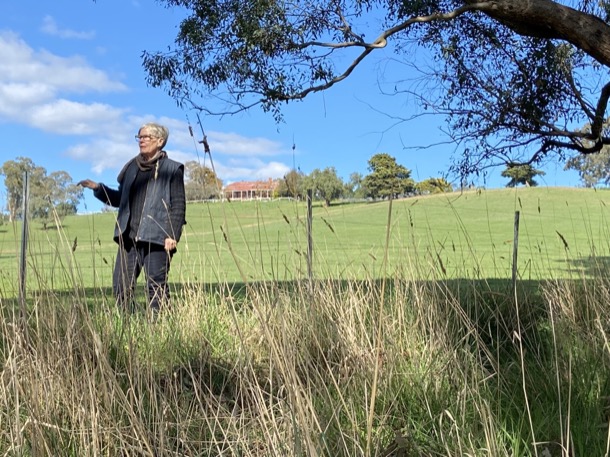
We turned to look out across the river to the hills beyond. What a view they had had. Not even the great 1870 flood would have reached the house perched right up there. And how close to the homestead the train line had been! The twice daily trains would have made their presence felt.
I thought about Grace, our grandmother growing up here, in this grand house, going to primary school in Molesworth, a short walk away. Her father, John, was an important man in the district, a Justice of the Peace and on the Yea council. When Grace was seven, the house had been extended and rebuilt.
A little further on we came across Balham Hill’s proper driveway, and a different view of the house. With her knowledgable eye, Sue noted the quality of the the land itself, and of the farming techniques, where many trees were left in the pastures.
With an eye on Google Maps, we drove on. The property up the road a bit had belonged to the previous generation: our great, great grandparents, James and Bridget Hamilton. We knew that they had selected the property, “Cremona” estate, 1220 acres, in 1866. It was “situated on the southern concave side of a great sweeping arc of the Goulburn River … rising to high ground in the south where it fronts the Whanregarwen Road.”
The "great sweeping arc” is still there, in spite of 150 years of floods and droughts. It means that the river leaves Whanregarwen Road at right angles. We stopped at that spot, looking out over the river flats. “This would have been Cremona land”, said Sue.
A farm bike pulled up alongside us. We can’t remember exactly what the man said, but it was something like “Can I help you?” but tinged with suspicion. As we wound down our windows, I thought of Chris’s quip about being ready to bail us out when we were picked up for loitering
After some explanations, Jono mentioned his and Sue’s nearby property on the Gobur Road, and it emerged that this young man, Matt Ridd, owned the business, Murrindindi Kitchens, who had put in their kitchen. The atmosphere warmed immediately, and Matt told us what he remembered of the old house at Cremona. His family, too, went back many generations in that area.
He was full of stories. The old house was gone before he was born, but he used to play around there, by the area known as the “old Cremona Drive”, where there were old bricks and things. There was an old brick lined well, down near the river, full of snakes. There had been a communal sheep wash at Balham Hill. We drank it all in eagerly.
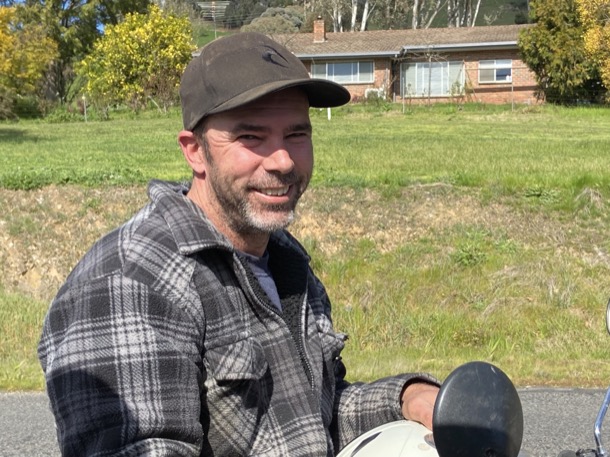
Eventually he turned his bike around and led us up the road, around the corner to an unmarked farm gate. We took photos, and pointed to twin lines of deciduous trees that could well have flanked Cremona’s driveway.
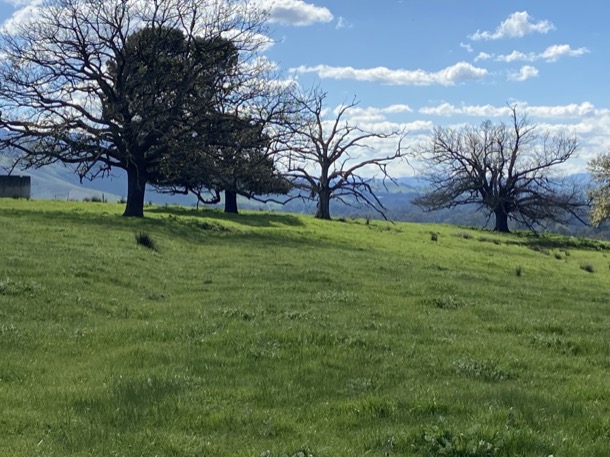
Off in the distance the river seemed a long way down. We had read the story of the 1870 flood surrounding and isolating the original house, and of James rescuing the family in the middle of the night, by crossing a flooded creek with horse and dray. Afterwards he rebuilt the house on much higher ground. Matt left us and we drove off in the other direction towards Alexandra.
As we drove, I pictured James driving his family to Sunday Mass along this road. The story goes that he would hurry up his daughters, complaining that his “Presbyterian horses couldn’t wait all day for lazy Catholics.”
The winding road down the hill into Alexandra from Cremona, is a familiar route for Jono and me. As we arrived in Alexandra, we were looking at the town with different eyes. We passed the impressive Shire Hall and Library and wondered whether any of the Hamiltons had graced the steps of either building. Charles Hamilton, James’s only son, and heir to Cremona was Shire president three times, so he may have even been involved in their creation.
The people with the answers are now in Alexandra Cemetery, our next destination.
We easily found the Catholic section with its assortment of Celtic Crosses, the tallest belonging to Charles’s wife Hannah, who died quite young, leaving two young children and a baby.
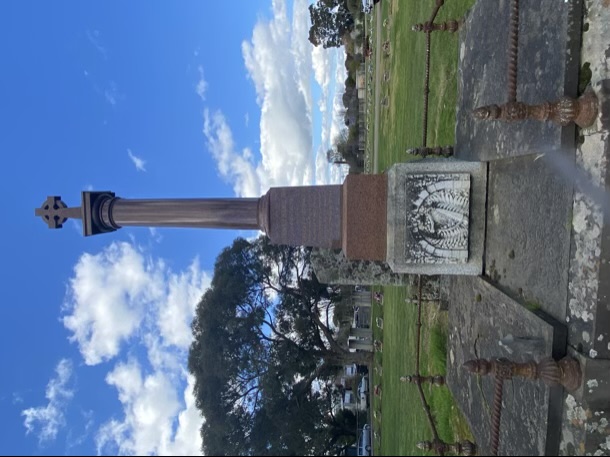
We did not find Charles or his parents in this section, so we decided to have Margaret’s salad rolls and a cup of tea in the sun and continue the search after lunch.
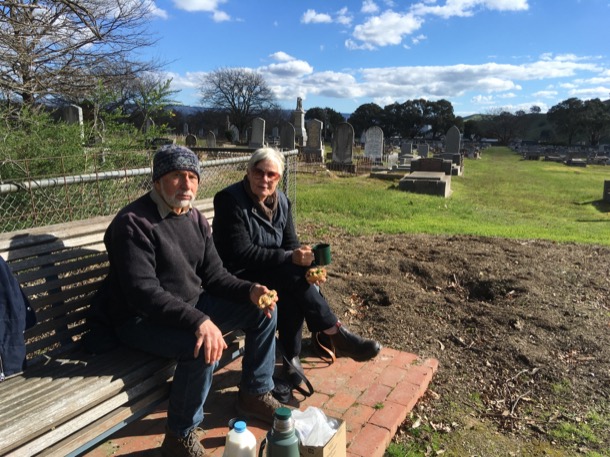
In the Protestant section, we did find more Hamiltons. Agnes, James’s mother, who emigrated with him, and James himself is also on the headstone. You may remember from our previous post, that they were both Protestants. Very fitting and buried in the correct section. Buried with them, is Brigid, who chose not to be buried in the Catholic section but here with her husband and mother in law. Their daughter Sara, who died at twenty-three, is also buried here. We did not find Charles although we do know he is buried at Alexandra too. Our excuse is that this was our first graveyard and we were not yet expert headstone hunters. I will return on my next trip into Alex with my new found expertise.
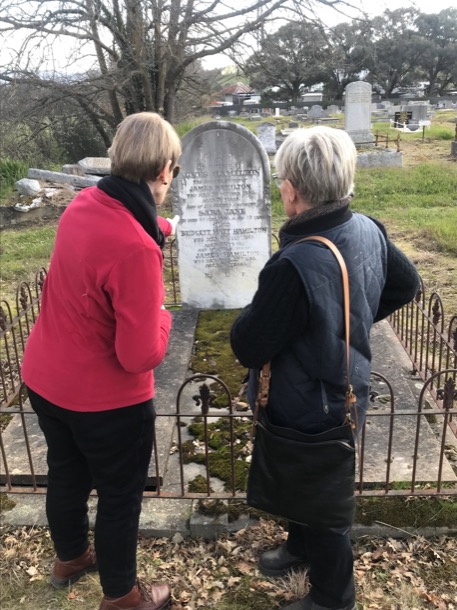
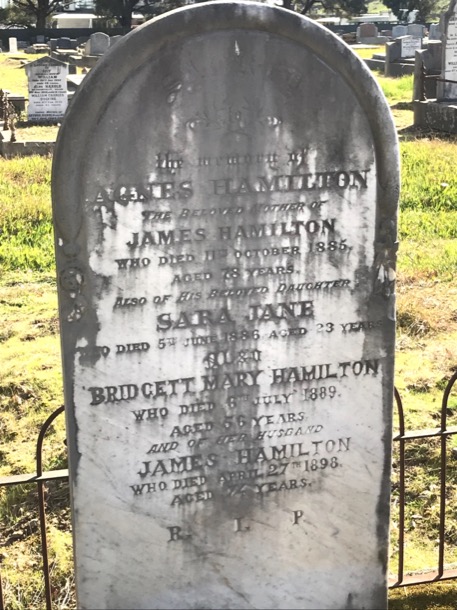
That night, in front of the fire at Sue and Jono’s house, as Jono cooked our Spanikopita dinner, Sue and I poured over our notes. I opened up and reread the 2006 article we had found in the journal “Eureka Street”, where Peter Hamilton, great grandson of the original Hamiltons of Cremona, describes his own visit to Alexandra cemetery, and the site of Cremona. Right there, in the article, was the name Les Ridd.
Matt Ridd, perched on his motorbike on the side of Whanregarwen Road, had described his dad’s recent illness, and here was a story about him taking Peter around Cremona in 2005.
Matt had given Sue his mobile number, and she texted him the link. Matt immediately rang back. Sue and Matt shared more stories. It was exciting to find that real world link with our past.
Later, on the strength of our interaction with Matt, I reached out to Peter Hamilton, author of the article. More about that in a later post.
The next morning, our first destination was Landscape at Tallarook. As we drove via Yea on the same route the young Hamilton girls would have taken, we again wondered how the three young ladies travelled to the Tallarook railhead and how long it took them. It took us fifty minutes on a good bitumen road.
Originally John McCormack Snr, of Red Barn, had bought the property, then called Tallarook House. Some of his sons had lived there, and, eventually one of them, James, became its long term owner.
After they were married, James and Grace changed the name of the property from Tallarook House to ‘Landscape.’ Archbishop Little in his small family history waxes lyrical about the property and the life there.
…….’Landscape’ a more fitting name for the unique and pleasant vistas of scenery viewed from its open wide verandahs.
After settling in at “Landscape”, husband and wife took a prominent part in the social, civic, charitable ,religious, and sporting life of the community and continued to do so throughout their lives. Landscape with its gracious hostess was a perfect setting…….
It is still is a beautiful, prime pastoral property. When it sold most recently in 2017, as a much reduced holding, it still boasted three kilometres of Goulburn River frontage.
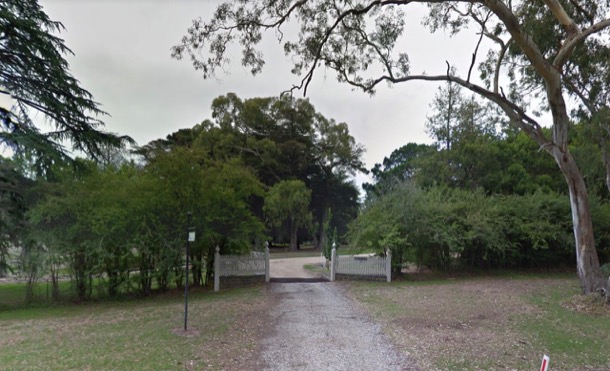
Landscape today still looks very much the gracious country house. It still sits amidst a cluster of small houses and large stone stables. The lovely old house overlooks the Goulburn and is set in a large well tended garden dominated by old stately trees. We wondered if James and Grace had planted the trees.
We wanted to stop and have a really good look, but the security cameras and the gentleman trimming the hedge were a little off putting. We settled for another drive past. On one side of the house Landscape now has its own vineyard, a more recent addition we think. Not so Tennis Court Paddock, on the other side of the house. No longer a tennis court, but we could imagine in days past it would have been a well used addition.
It was a short drive from Landscape to Tallarook. The old railway line, now a rail trail, had followed the road. It culminated in the Tallarook Railway Station, which is still in operation, on the main Melbourne to Sydney line. Back when James McCormack was establishing himself in the district, it was the railhead. Although much reduced in capacity and importance, it still has the feeling of a substantial, permanent structure. What had been high wide doors have been bricked in. There are a few historical signs, but it was hard to get a sense of the bustling, smelly, noisy place it once would have been. We took photos and moved on.
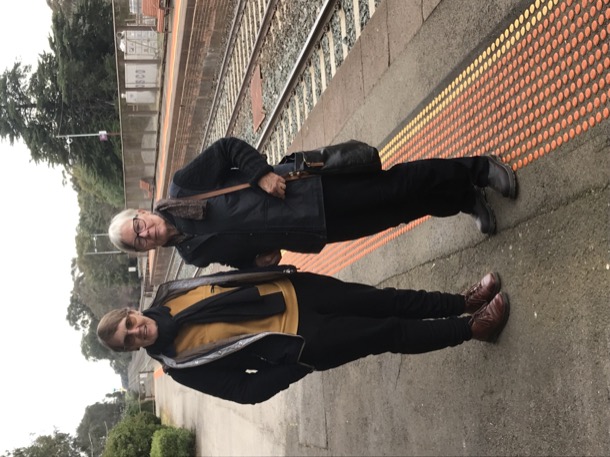
We drove into the grassy grounds of St Joseph’s. There is very little information about this church. It was blessed in July 3rd 1887 by Archbishop Carr.
It is sad to realise that this beautiful bluestone building is now virtually unused. It is not listed on the Diocese website.
Jono had sent an email to the Seymour parish priest the day before, in the hope that we might get a peek inside, but there was no reply.
The slate roof looked sound, and all the windows were intact, thanks to heavy wire screens on the outside of them. Archbishop Little tells us that “The memory of Grace and James McCormack has been retained in the Catholic community of Tallarook by the erection in St. Joseph's Church of ornate stained glass windows…”
We couldn’t really see the windows very well from the outside, but they looked substantial.
The only other buildings on the block were two little ramshackle outdoor dunnies, tucked under the trees on the outskirts of the cleared area.”
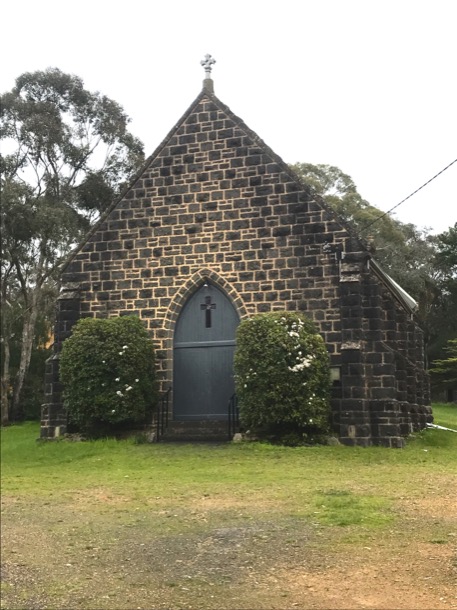
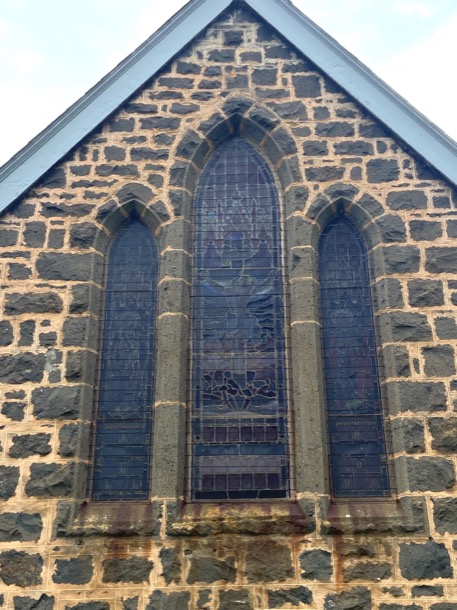
James and Grace had been dominating our thoughts in Tallarook, and now we drove on the the Seymour cemetery to find their graves.
Far from finding a quiet country cemetery, we found ourselves over the road from the busy midweek races at the Seymour Racetrack. Dodging horse floats, we turned right and parked in the cemetery grounds. We huddled quietly by the car, hoping that we weren’t intruding on a funeral still in progress. The land around Seymour is dry and stony, and heavy grey skies reminded us that rain had been forecast.
The sections in the cemetery were clearly labelled, and we headed toward the forest of Celtic Crosses in the Catholic section.
There were McCormacks everywhere. But the largest marble Celtic cross marked the graves of Grace, aged 56 and James JP (Justin of the Peace), aged 78.
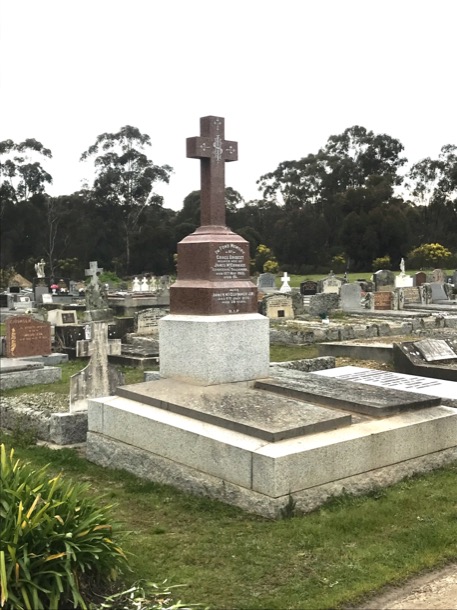
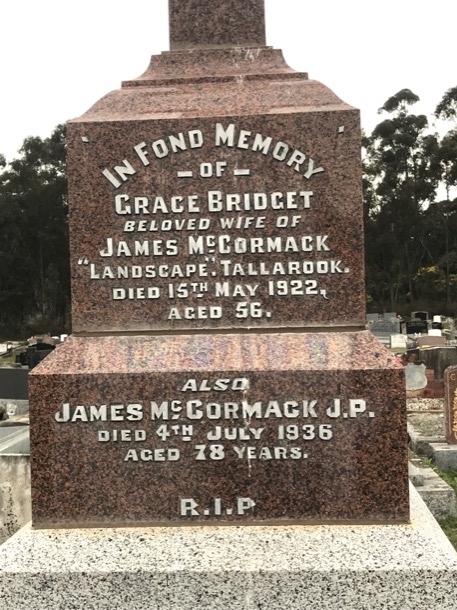
We drove through Seymour. I tried to see it as it had been when James was president of the Council, but the church has been rebuilt, the town has grown, and the sad, unkempt, crowded together little houses and struggling small businesses overpower any sense of history.
Rain was still threatening, and the wind was cold, as we pulled up at the Tourist Park alongside the river in Euroa. Parked a few cars away, was Janet, who Sue and Jono knew from Trust for Nature. Janet is a local landowner, active in all local environmental organisations and activities. She was cleaning up, after running a morning water-quality training session in the river.
When we explained our mission, she exclaimed, in her larger-than-life voice,
“Oh! Are you related to the McCormacks?”
“Yes, our grandmother was a McCormack.”
It felt real. We did belong to these people: men who had dominated four local councils and been part of all the important local infrastructure decisions for the second half of the nineteenth century, and the beginning of the twentieth. Families whose weddings were written up in the local papers, whose names were on the stained glass windows in the churches, whose memorials dominated the cemeteries.
We ate our egg sandwiches and drank tea from the thermos huddled in a shelter by the river. Euroa felt older, more solid and prosperous than Seymour.
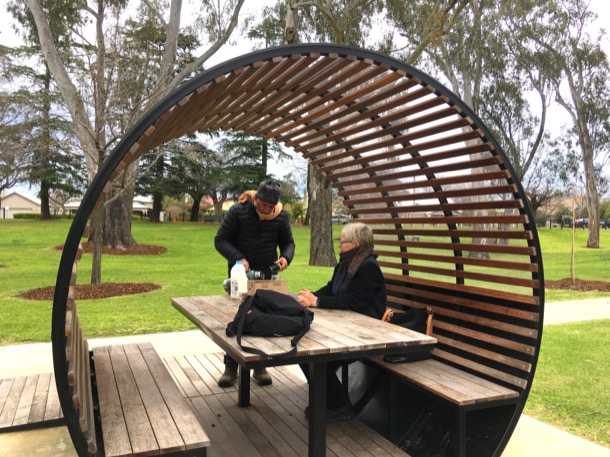
The Euroa McCormack was Thomas, the eldest of John and Jane’s children, born at Red Barn in Beveridge. We hadn’t spent much time exploring Thomas’s story, because we had been so taken by the romance of his younger brothers, James, John and Michael who had married the three Hamilton sisters. But here, in Euroa, it felt important to fit him into the story.
We had a few notes, (and a bit of subsequent expert input, to be explained later) and spent a bit of time pulling his story together.
Thomas was the eldest son of John and Jane McCormack of Red Barn Beveridge. He was born in 1851.
After living with his brothers James and Michael at Landscape, Thomas purchased a property in Mooroopna, near Shepparton, in 1882.
The property was called “The Desert”, and was in Toolamba Road. Like the other family properties, Thomas’s was along the Goulburn River, but much further north.
Soon after moving to Mooroopna, Thomas married Bridget Agnes Cooke, of Pyalong. There’s more to find our about this, but we think that Bridget’s brother John might have also invested in this property. Over time, it seems that the property developed into a “fine property” called May Park Estate.
Thomas and Bridget were active community members. In particular, Thomas was very involved with the Mooroopna Hospital Board. They had four sons and two daughters.
In 1908, Thomas and Bridget sold up in Mooroopna and bought “Springside” in Gooram, near Euroa. Thomas was 57, and Bridget, 55. It seems they immediately became involved in their new community.
In 1912, Bridget became sick with colon cancer. After a difficult two years, she died. She was 61.
Thomas remarried two years later, in 1916. We don’t know much about his second wife, Elizabeth. She was the daughter of Patrick and Elizabeth O’Connor of “Parkview”, Kilmore.
Then, in 1918, further tragedy struck. Daughter Mary, who lived with Thomas and Elizabeth at Gooram, died, aged thirty.
We can only speculate about Thomas’s motives, but, quite soon, he sold up and they moved into town. His new house was “Marengo” in Anderson St.
Thomas and Elizabeth had thirteen years together. It seems they built a busy, community-focussed life in Euroa. Among other things, Thomas was involved in the District Racing Club, the Agricultural Society, the Band, the Swimming Club and the Bush Nursing Hospital.
Thomas died in 1929, aged 78.
Elizabeth, who is buried alongside him in Euroa, lived in Hawthorn for a further fourteen years. She died in 1943.
Euroa Cemetery, like Seymour Cemetery, is in a rather uninspiring location. Separated from the town by the Hume Freeway, it sits amongst flat empty paddocks.
It was still cold and raining a little, as we approached the rows of graves, looking for the Catholic section and the telltale sign of the Celtic Crosses. Well practised now, we headed for the tallest cross.
Sure enough, we found the McCormack’s lichen encrusted, but still readable, very large granite Celtic Cross. Buried here are Thomas McCormack and Brigid, his first wife, and mother of his children, who died fourteen years before him. Only four years later, Mary their daughter also died, and is buried with her parents. Many years later, in 1943, Elizabeth, Thomas’s second wife, was also interred in this plot. She had lived in Hawthorn after Thomas’s death, but chose to be buried here with him.
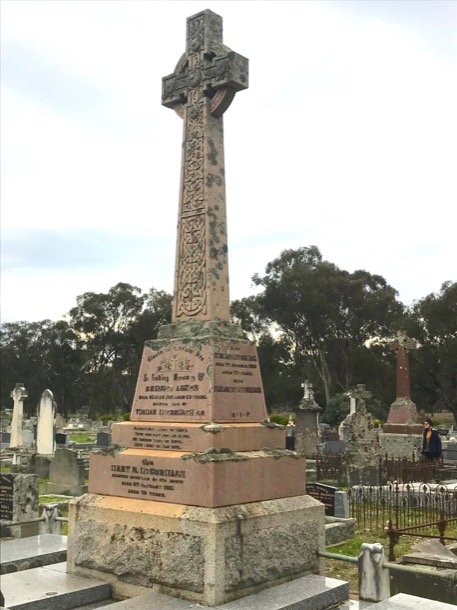
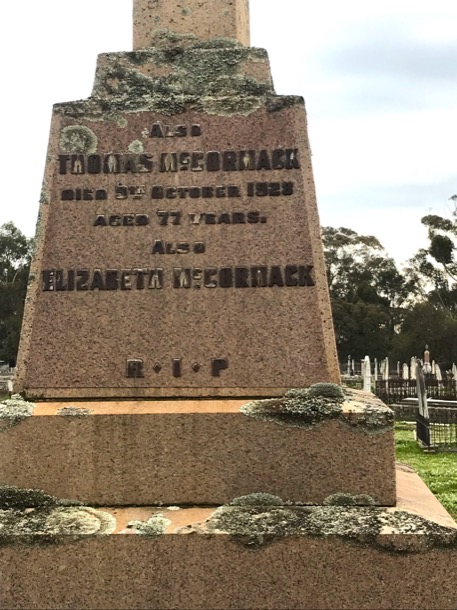
We were also fascinated to see, crowded in next to the McCormack plot, the priests and nuns of Euroa. Notably, the nuns' graves were a little smaller.
Having found Thomas’s grave we set off to find his property, Springside, at Gooram.
We drove into the Strathbogie Ranges on the beautiful Euroa-Merton Road for seventeen kilometres, and then turned right, onto a long straight road that followed the valley.
It was a lovely tree-lined road with only one or two properties along it. It seemed very remote to us. What must it have been like when Thomas and Brigid lived here?
The first indication that we were there, was a large new sign, ‘Springside’ at the beginning of a long drive that disappeared over the hill.
Of great interest though was the very large Banksia marginata on the road verge, right opposite the gate. There are very few original Banksia marginata left in the Strathbogie Ranges, and we had never seen such a large one. We wondered how old it was and if it had been growing there, as Thomas and family drove and rode past.
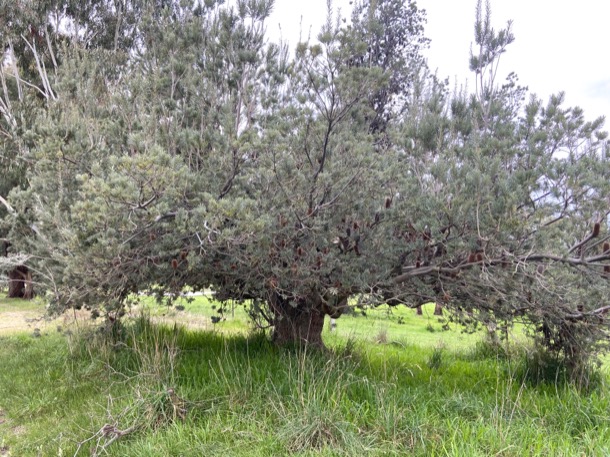
As no house was obvious here, we drove on. Almost at the end of the road, there was the house, sitting quietly in its old garden. It is not as grand a house as Landscape, but it looks substantial and comfortable. Thomas’s white, weatherboard house is surrounded on three sides by a wide verandah and we could imagine Thomas sitting on the verandah, looking across the lush paddocks to the distant hills, fires roaring in the fireplaces inside. It was certainly a lovely spot.

Our last day of graveyard hopping dawned cold and wet again. Very appropriate and atmospheric weather, and Yea Cemetery did not disappoint.
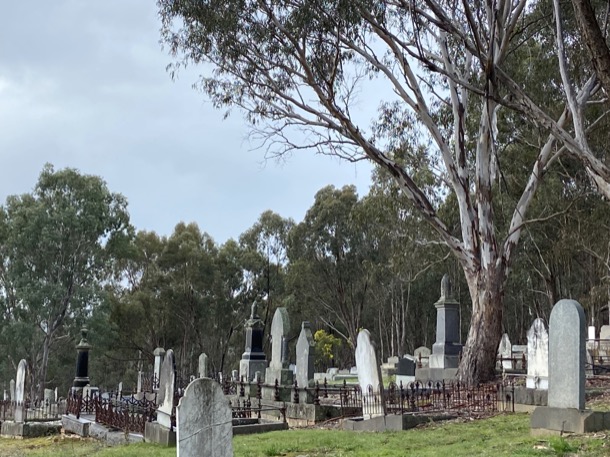
The old cemetery, surrounded by bushland, was tucked away on the hill, behind Yea township. The newer section of the cemetery, lies bland, uninteresting and uninspiring, out of sight.
Unlike all the other cemeteries that have been in flat and open expanses, Yea is set in a hilly spot. We arrived and walked up the small, treed hill, looking once again for the Catholic section. Not as many Celtic Crosses to guide us here and no clear signage. Near the top of the hill we began to see the Irish surnames, so the hunt for our great grandparents began in earnest. It was raining more heavily now, and we thought we were to be disappointed, but Jono saved the day.
Not a Celtic Cross, but a large impressive slab, with all that we sought buried here. It was sobering to think that our grandmother, Grace had stood here, as the bodies of John and Joan (previously called Johanna) McCormack, her parents, were interred. Maybe our father as a four year old child had been there too.
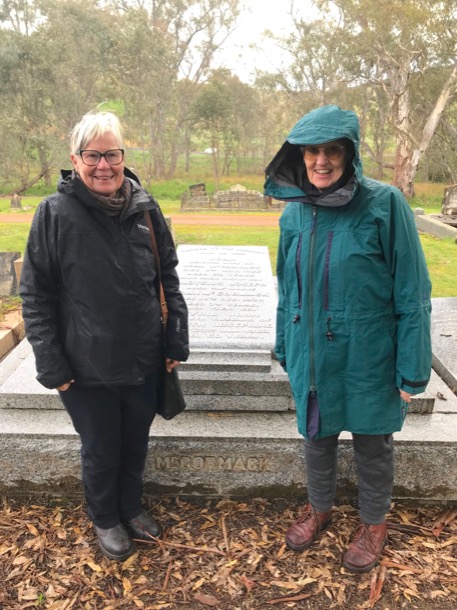
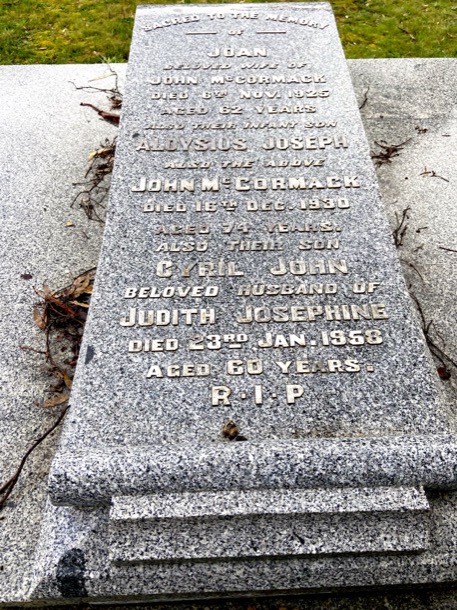
Also on the stone were John’s and Joan’s infant son Aloysius who died aged ten months and Cyril, Grace’s brother and his wife Judith. Quite a family plot.
What a beautiful little cemetery in which to end our journey around Central Victoria and how fitting to end it with the resting place of our great grandparents.
Now, after months of piecing together the McCormack and Hamilton backgrounds, marvelling at the story of three McCormack boys marrying three Hamilton girls, we were going to visit the actual sites. Very conveniently, we could stay at Sue and Jono’s property nearby. We roughed out an itinerary, and a food and wine list. The forecast was dubious, but we would mostly be in the car. Jono offered himself as designated driver.
On the first morning, we pulled into Molesworth, familiar as the second last town before Sue and Jono’s road. I looked at the hall, right on the main road. We took pictures, and peered in the dirty windows.

It wasn’t until I walked down the side of the building that the significance of it all hit me. There, on a hill behind the town strip, sat Balham Hill, the red brick house our grandmother grew up in. Her father had donated the land for the hall. We noted that the hill was much too steep for young ladies to navigate.
The right turn into Whanregarwen Road was very near. We parked in the clearing next to the Rail Trail, and Sue and I climbed a rough cutting until we could see Balham Hill again, in its home paddock.

We turned to look out across the river to the hills beyond. What a view they had had. Not even the great 1870 flood would have reached the house perched right up there. And how close to the homestead the train line had been! The twice daily trains would have made their presence felt.
I thought about Grace, our grandmother growing up here, in this grand house, going to primary school in Molesworth, a short walk away. Her father, John, was an important man in the district, a Justice of the Peace and on the Yea council. When Grace was seven, the house had been extended and rebuilt.
A little further on we came across Balham Hill’s proper driveway, and a different view of the house. With her knowledgable eye, Sue noted the quality of the the land itself, and of the farming techniques, where many trees were left in the pastures.
With an eye on Google Maps, we drove on. The property up the road a bit had belonged to the previous generation: our great, great grandparents, James and Bridget Hamilton. We knew that they had selected the property, “Cremona” estate, 1220 acres, in 1866. It was “situated on the southern concave side of a great sweeping arc of the Goulburn River … rising to high ground in the south where it fronts the Whanregarwen Road.”
The "great sweeping arc” is still there, in spite of 150 years of floods and droughts. It means that the river leaves Whanregarwen Road at right angles. We stopped at that spot, looking out over the river flats. “This would have been Cremona land”, said Sue.
A farm bike pulled up alongside us. We can’t remember exactly what the man said, but it was something like “Can I help you?” but tinged with suspicion. As we wound down our windows, I thought of Chris’s quip about being ready to bail us out when we were picked up for loitering
After some explanations, Jono mentioned his and Sue’s nearby property on the Gobur Road, and it emerged that this young man, Matt Ridd, owned the business, Murrindindi Kitchens, who had put in their kitchen. The atmosphere warmed immediately, and Matt told us what he remembered of the old house at Cremona. His family, too, went back many generations in that area.
He was full of stories. The old house was gone before he was born, but he used to play around there, by the area known as the “old Cremona Drive”, where there were old bricks and things. There was an old brick lined well, down near the river, full of snakes. There had been a communal sheep wash at Balham Hill. We drank it all in eagerly.

Eventually he turned his bike around and led us up the road, around the corner to an unmarked farm gate. We took photos, and pointed to twin lines of deciduous trees that could well have flanked Cremona’s driveway.

Off in the distance the river seemed a long way down. We had read the story of the 1870 flood surrounding and isolating the original house, and of James rescuing the family in the middle of the night, by crossing a flooded creek with horse and dray. Afterwards he rebuilt the house on much higher ground. Matt left us and we drove off in the other direction towards Alexandra.
As we drove, I pictured James driving his family to Sunday Mass along this road. The story goes that he would hurry up his daughters, complaining that his “Presbyterian horses couldn’t wait all day for lazy Catholics.”
The winding road down the hill into Alexandra from Cremona, is a familiar route for Jono and me. As we arrived in Alexandra, we were looking at the town with different eyes. We passed the impressive Shire Hall and Library and wondered whether any of the Hamiltons had graced the steps of either building. Charles Hamilton, James’s only son, and heir to Cremona was Shire president three times, so he may have even been involved in their creation.
The people with the answers are now in Alexandra Cemetery, our next destination.
We easily found the Catholic section with its assortment of Celtic Crosses, the tallest belonging to Charles’s wife Hannah, who died quite young, leaving two young children and a baby.

We did not find Charles or his parents in this section, so we decided to have Margaret’s salad rolls and a cup of tea in the sun and continue the search after lunch.

In the Protestant section, we did find more Hamiltons. Agnes, James’s mother, who emigrated with him, and James himself is also on the headstone. You may remember from our previous post, that they were both Protestants. Very fitting and buried in the correct section. Buried with them, is Brigid, who chose not to be buried in the Catholic section but here with her husband and mother in law. Their daughter Sara, who died at twenty-three, is also buried here. We did not find Charles although we do know he is buried at Alexandra too. Our excuse is that this was our first graveyard and we were not yet expert headstone hunters. I will return on my next trip into Alex with my new found expertise.


That night, in front of the fire at Sue and Jono’s house, as Jono cooked our Spanikopita dinner, Sue and I poured over our notes. I opened up and reread the 2006 article we had found in the journal “Eureka Street”, where Peter Hamilton, great grandson of the original Hamiltons of Cremona, describes his own visit to Alexandra cemetery, and the site of Cremona. Right there, in the article, was the name Les Ridd.
Matt Ridd, perched on his motorbike on the side of Whanregarwen Road, had described his dad’s recent illness, and here was a story about him taking Peter around Cremona in 2005.
Matt had given Sue his mobile number, and she texted him the link. Matt immediately rang back. Sue and Matt shared more stories. It was exciting to find that real world link with our past.
Later, on the strength of our interaction with Matt, I reached out to Peter Hamilton, author of the article. More about that in a later post.
The next morning, our first destination was Landscape at Tallarook. As we drove via Yea on the same route the young Hamilton girls would have taken, we again wondered how the three young ladies travelled to the Tallarook railhead and how long it took them. It took us fifty minutes on a good bitumen road.
Originally John McCormack Snr, of Red Barn, had bought the property, then called Tallarook House. Some of his sons had lived there, and, eventually one of them, James, became its long term owner.
After they were married, James and Grace changed the name of the property from Tallarook House to ‘Landscape.’ Archbishop Little in his small family history waxes lyrical about the property and the life there.
…….’Landscape’ a more fitting name for the unique and pleasant vistas of scenery viewed from its open wide verandahs.
After settling in at “Landscape”, husband and wife took a prominent part in the social, civic, charitable ,religious, and sporting life of the community and continued to do so throughout their lives. Landscape with its gracious hostess was a perfect setting…….
It is still is a beautiful, prime pastoral property. When it sold most recently in 2017, as a much reduced holding, it still boasted three kilometres of Goulburn River frontage.

Landscape today still looks very much the gracious country house. It still sits amidst a cluster of small houses and large stone stables. The lovely old house overlooks the Goulburn and is set in a large well tended garden dominated by old stately trees. We wondered if James and Grace had planted the trees.
We wanted to stop and have a really good look, but the security cameras and the gentleman trimming the hedge were a little off putting. We settled for another drive past. On one side of the house Landscape now has its own vineyard, a more recent addition we think. Not so Tennis Court Paddock, on the other side of the house. No longer a tennis court, but we could imagine in days past it would have been a well used addition.
It was a short drive from Landscape to Tallarook. The old railway line, now a rail trail, had followed the road. It culminated in the Tallarook Railway Station, which is still in operation, on the main Melbourne to Sydney line. Back when James McCormack was establishing himself in the district, it was the railhead. Although much reduced in capacity and importance, it still has the feeling of a substantial, permanent structure. What had been high wide doors have been bricked in. There are a few historical signs, but it was hard to get a sense of the bustling, smelly, noisy place it once would have been. We took photos and moved on.

We drove into the grassy grounds of St Joseph’s. There is very little information about this church. It was blessed in July 3rd 1887 by Archbishop Carr.
It is sad to realise that this beautiful bluestone building is now virtually unused. It is not listed on the Diocese website.
Jono had sent an email to the Seymour parish priest the day before, in the hope that we might get a peek inside, but there was no reply.
The slate roof looked sound, and all the windows were intact, thanks to heavy wire screens on the outside of them. Archbishop Little tells us that “The memory of Grace and James McCormack has been retained in the Catholic community of Tallarook by the erection in St. Joseph's Church of ornate stained glass windows…”
We couldn’t really see the windows very well from the outside, but they looked substantial.
The only other buildings on the block were two little ramshackle outdoor dunnies, tucked under the trees on the outskirts of the cleared area.”


James and Grace had been dominating our thoughts in Tallarook, and now we drove on the the Seymour cemetery to find their graves.
Far from finding a quiet country cemetery, we found ourselves over the road from the busy midweek races at the Seymour Racetrack. Dodging horse floats, we turned right and parked in the cemetery grounds. We huddled quietly by the car, hoping that we weren’t intruding on a funeral still in progress. The land around Seymour is dry and stony, and heavy grey skies reminded us that rain had been forecast.
The sections in the cemetery were clearly labelled, and we headed toward the forest of Celtic Crosses in the Catholic section.
There were McCormacks everywhere. But the largest marble Celtic cross marked the graves of Grace, aged 56 and James JP (Justin of the Peace), aged 78.


We drove through Seymour. I tried to see it as it had been when James was president of the Council, but the church has been rebuilt, the town has grown, and the sad, unkempt, crowded together little houses and struggling small businesses overpower any sense of history.
Rain was still threatening, and the wind was cold, as we pulled up at the Tourist Park alongside the river in Euroa. Parked a few cars away, was Janet, who Sue and Jono knew from Trust for Nature. Janet is a local landowner, active in all local environmental organisations and activities. She was cleaning up, after running a morning water-quality training session in the river.
When we explained our mission, she exclaimed, in her larger-than-life voice,
“Oh! Are you related to the McCormacks?”
“Yes, our grandmother was a McCormack.”
It felt real. We did belong to these people: men who had dominated four local councils and been part of all the important local infrastructure decisions for the second half of the nineteenth century, and the beginning of the twentieth. Families whose weddings were written up in the local papers, whose names were on the stained glass windows in the churches, whose memorials dominated the cemeteries.
We ate our egg sandwiches and drank tea from the thermos huddled in a shelter by the river. Euroa felt older, more solid and prosperous than Seymour.

The Euroa McCormack was Thomas, the eldest of John and Jane’s children, born at Red Barn in Beveridge. We hadn’t spent much time exploring Thomas’s story, because we had been so taken by the romance of his younger brothers, James, John and Michael who had married the three Hamilton sisters. But here, in Euroa, it felt important to fit him into the story.
We had a few notes, (and a bit of subsequent expert input, to be explained later) and spent a bit of time pulling his story together.
Thomas was the eldest son of John and Jane McCormack of Red Barn Beveridge. He was born in 1851.
After living with his brothers James and Michael at Landscape, Thomas purchased a property in Mooroopna, near Shepparton, in 1882.
The property was called “The Desert”, and was in Toolamba Road. Like the other family properties, Thomas’s was along the Goulburn River, but much further north.
Soon after moving to Mooroopna, Thomas married Bridget Agnes Cooke, of Pyalong. There’s more to find our about this, but we think that Bridget’s brother John might have also invested in this property. Over time, it seems that the property developed into a “fine property” called May Park Estate.
Thomas and Bridget were active community members. In particular, Thomas was very involved with the Mooroopna Hospital Board. They had four sons and two daughters.
In 1908, Thomas and Bridget sold up in Mooroopna and bought “Springside” in Gooram, near Euroa. Thomas was 57, and Bridget, 55. It seems they immediately became involved in their new community.
In 1912, Bridget became sick with colon cancer. After a difficult two years, she died. She was 61.
Thomas remarried two years later, in 1916. We don’t know much about his second wife, Elizabeth. She was the daughter of Patrick and Elizabeth O’Connor of “Parkview”, Kilmore.
Then, in 1918, further tragedy struck. Daughter Mary, who lived with Thomas and Elizabeth at Gooram, died, aged thirty.
We can only speculate about Thomas’s motives, but, quite soon, he sold up and they moved into town. His new house was “Marengo” in Anderson St.
Thomas and Elizabeth had thirteen years together. It seems they built a busy, community-focussed life in Euroa. Among other things, Thomas was involved in the District Racing Club, the Agricultural Society, the Band, the Swimming Club and the Bush Nursing Hospital.
Thomas died in 1929, aged 78.
Elizabeth, who is buried alongside him in Euroa, lived in Hawthorn for a further fourteen years. She died in 1943.
Euroa Cemetery, like Seymour Cemetery, is in a rather uninspiring location. Separated from the town by the Hume Freeway, it sits amongst flat empty paddocks.
It was still cold and raining a little, as we approached the rows of graves, looking for the Catholic section and the telltale sign of the Celtic Crosses. Well practised now, we headed for the tallest cross.
Sure enough, we found the McCormack’s lichen encrusted, but still readable, very large granite Celtic Cross. Buried here are Thomas McCormack and Brigid, his first wife, and mother of his children, who died fourteen years before him. Only four years later, Mary their daughter also died, and is buried with her parents. Many years later, in 1943, Elizabeth, Thomas’s second wife, was also interred in this plot. She had lived in Hawthorn after Thomas’s death, but chose to be buried here with him.


We were also fascinated to see, crowded in next to the McCormack plot, the priests and nuns of Euroa. Notably, the nuns' graves were a little smaller.
Having found Thomas’s grave we set off to find his property, Springside, at Gooram.
We drove into the Strathbogie Ranges on the beautiful Euroa-Merton Road for seventeen kilometres, and then turned right, onto a long straight road that followed the valley.
It was a lovely tree-lined road with only one or two properties along it. It seemed very remote to us. What must it have been like when Thomas and Brigid lived here?
The first indication that we were there, was a large new sign, ‘Springside’ at the beginning of a long drive that disappeared over the hill.
Of great interest though was the very large Banksia marginata on the road verge, right opposite the gate. There are very few original Banksia marginata left in the Strathbogie Ranges, and we had never seen such a large one. We wondered how old it was and if it had been growing there, as Thomas and family drove and rode past.

As no house was obvious here, we drove on. Almost at the end of the road, there was the house, sitting quietly in its old garden. It is not as grand a house as Landscape, but it looks substantial and comfortable. Thomas’s white, weatherboard house is surrounded on three sides by a wide verandah and we could imagine Thomas sitting on the verandah, looking across the lush paddocks to the distant hills, fires roaring in the fireplaces inside. It was certainly a lovely spot.

Our last day of graveyard hopping dawned cold and wet again. Very appropriate and atmospheric weather, and Yea Cemetery did not disappoint.

The old cemetery, surrounded by bushland, was tucked away on the hill, behind Yea township. The newer section of the cemetery, lies bland, uninteresting and uninspiring, out of sight.
Unlike all the other cemeteries that have been in flat and open expanses, Yea is set in a hilly spot. We arrived and walked up the small, treed hill, looking once again for the Catholic section. Not as many Celtic Crosses to guide us here and no clear signage. Near the top of the hill we began to see the Irish surnames, so the hunt for our great grandparents began in earnest. It was raining more heavily now, and we thought we were to be disappointed, but Jono saved the day.
Not a Celtic Cross, but a large impressive slab, with all that we sought buried here. It was sobering to think that our grandmother, Grace had stood here, as the bodies of John and Joan (previously called Johanna) McCormack, her parents, were interred. Maybe our father as a four year old child had been there too.


Also on the stone were John’s and Joan’s infant son Aloysius who died aged ten months and Cyril, Grace’s brother and his wife Judith. Quite a family plot.
What a beautiful little cemetery in which to end our journey around Central Victoria and how fitting to end it with the resting place of our great grandparents.
Comments
Families Along the Goulburn
19 07 23 14:00 Filed in: Jim
Recently we discovered a bit more about the Molesworth branch of our dad’s family. Down the rabbit hole we went.
It took weeks to piece together the snippets of information we had. We doubled checked information, discarded red herrings, created a timeline. We complained about the way names appeared and reappeared in different generations. We cut and pasted a colour coded chart. Finally, gradually, the stories came into focus in our minds.
Our story begins in Ireland.
Four families: McCormacks, Fords, Hamiltons and Ryans
Three of the families, the McCormacks. the Fords and the Ryans, all Catholics, all emigrated about 1848 from Southern Ireland: Limerick, Galway and Tipperary
The fourth family, the Hamiltons, were protestants, of Scottish Irish heritage. They emigrated from Antrim, Northern Ireland, also in 1848.
The Northern Irish Hamiltons arrived with some money, ready to buy land. But
our Southern IrIsh were probably driven out by the general economic turmoil and devastation caused by the Irish Potato Famine of 1845-1852.
At that time, the vast majority of the Irish Catholic population had little or no access to land ownership and many lived in appalling poverty.
Ninety percent of the land in Ireland was owned by Protestant landowners, who rented it out in small parcels to Irish tenant farmers. Already poor and dependent on the potato crop, Irish families starved when successive harvests failed, due to Potato Blight. As a result, Irish people emigrated in large numbers, land hungry and ready to and make their fortunes.
The colony the McCormacks, Fords, Hamiltons and Ryans arrived and settled in, had been ‘opened up’ by the squatters coming down from north of the Murray and inland from Portland. The Aboriginal tribes had been largely dispossessed, vast fortunes had been made, and the landed aristocracy had emerged as a powerful force in the burgeoning colony.
It is both expected and fascinating to see our Irish immigrant forbears’ land acquisition and prosperity mirrored, in the opening up of land for settlement in Victoria. This took place over several decades, primarily through a series of land acts, designed to break up the vast holdings of the squatters and encourage agricultural development, population growth, and the establishment of communities.
Between 1865 and 1890 Land Acts enabled land to be acquired at a fair price, and paid off in instalments. Specified improvements had to be made such as fencing, clearing and cultivation.
As we will see, our Irish families also benefitted from the growth and prosperity stemming from the Gold Rush. In 1851 gold was discovered in Ballarat, leading to the 1850s Gold Rush, a transformative event in Victorian history.
The colony grew rapidly in both population and economic power and our families, among others, took full advantage of the opportunities offered.
They set about the serious business of acquiring property supplying the new, lucrative, growing market with their produce. Country towns around them grew and with increased wealth, substantial civic buildings and churches were built. Railways and roads were constructed providing quicker and easier access to markets and facilitating social and family connections.
It would have been an exciting time for our four families, as they bought and developed their land holdings and participated in the civic life of the Colony of Victoria, with its own Lieutenant-Governor and elected Victorian Legislative Council.
During the first fifteen years after arriving in the colony, our four Irish Families became two couples.
1 James Hamilton and Bridget Ryan
The protestant Hamilton family from Northern Ireland comprised only a mother and son. We know that James Hamilton’s father had recently died. James was in his late teens, when he and his mother emigrated to Port Phillip, with enough capital to acquire a property in the colony. They chose Upper Plenty, which at that time was a rural area.
The Ryan family also emigrated about 1848.
About seven years later, in 1855, James Hamilton married Bridget Ryan. Bridget was a Catholic. Sue and I know something of this quandary, being daughters of a similar “mixed marriage”. The wedding was held on a property “Richland” near the Hamilton’s place at Upper Plenty. The property belonged to Mr David Johnston
Archbishop Little, who is also related to these four families and has written about them, has a bit to say about this marriage:
“… the marriage of James and Bridget was a truly valid Catholic marriage in the eyes of the Church.”
What he means here is that James would have agreed to the children of the marriage being brought up Catholics. He certainly followed through with this, even driving his wife and children to church on Sundays. Two of their daughters later became nuns.
James and Bridget stayed on for a further twelve years in Upper Plenty, where the first six of their children were born. These children included Charles, Grace, Johanna and Kate. Johanna was our Great Grandmother.
Then, in 1866, they acquired “Cremona Estate”, near present day Molesworth. They ran dairy and beef cattle and grew cereals on the rich
river flats.
Cremona homestead was "situated on the southern concave side of a great sweeping arc of the Goulburn river ….. it fronts the Whanregarwen road distant some three miles east from the present township of Molesworth" 1866:
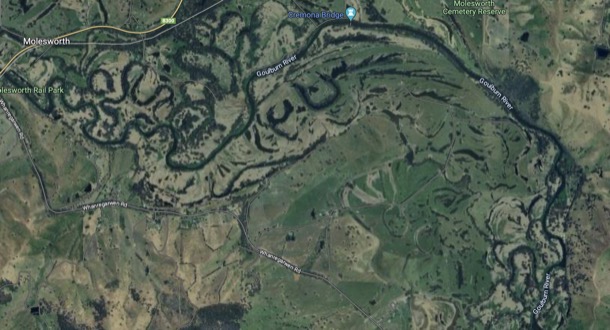
Six further children, another five of them girls, were born at Cremona, before Bridget’s death, at the age of 56, in 1889.
Archbishop Little writes glowingly of life at Cremona, and of the three eldest Hamilton girls in particular. He describes them as “charming, refined, eligible and capable young ladies.” He describes the children’s education. An in-house private tutor taught them Art, Music and Painting, as well as academic subjects. But they all helped out on the farm as well, including the older girls, Grace, Johanna and Kate.
2 John McCormack Snr and Jane Ford
We don’t know the initial activities of the McCormack and Ford families, until, in 1850, two years after landing in Port Phillip, John McCormack (Senior) married Jane Ford at St Francis Church on the corner of Lonsdale and Elizabeth streets in Melbourne. Both had been in their late twenties and unmarried when they emigrated.
St Francis church today, the oldest still operating Catholic church in Victoria:
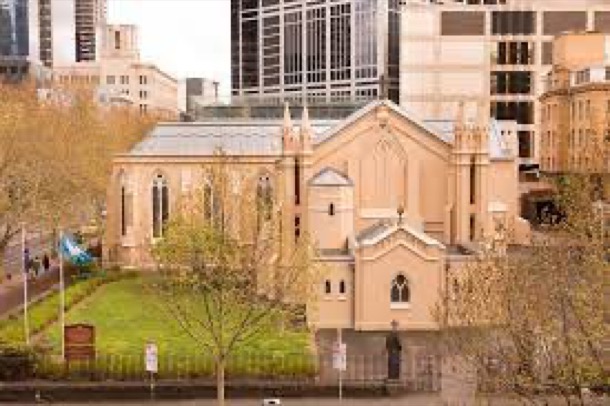
The couple settled near present day Beveridge, renting a property “Red Barn”. The property was very near the main road from Melbourne to Sydney. The family worked hard and developed a dairy herd, specialising in cheese, which they initially sold to passing diggers on their way to the goldfields.
Red Barn Lane today:
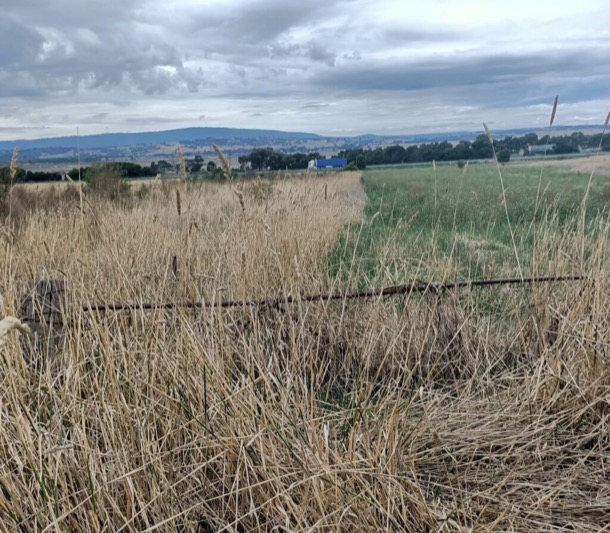
There was money to be made, so much, that the couple were later able to settle their sons on properties along the Goulburn River.
The first, of these, in 1876, was the eldest, James McCormack, then aged 18. His property, called Tallarook House, (later renamed Landscape), was at Tallarook, a hundred kilometres from Mebourne. James was unmarried at this stage and Tallarook House remained without a mistress for a further twelve years. Clearly, James was very involved in the community. He was elected as a councillor for the Shire of Seymour in 1887.
"Landscape" today:
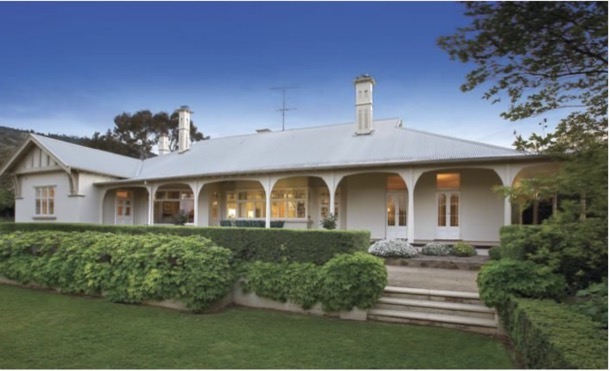
"Landscape" interior:

The second McCormack to be settled along the Goulburn River, was John Jnr. His property, acquired in 1886, called Balham Hill, was near Molesworth. He also became a councillor, for Yea Shire.
Balham Hill:
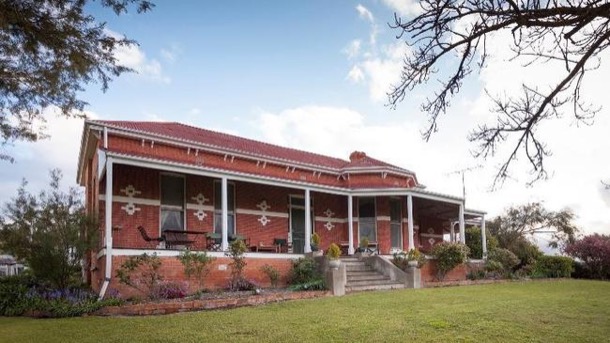
Balham Hill property:
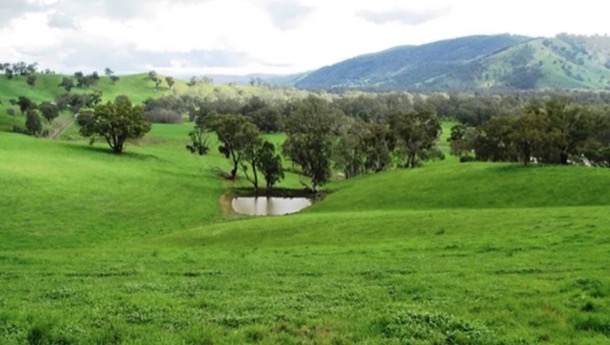
The Big Romance
So now we have three properties along the Goulburn. James and Bridget Hamilton’s Cremona and John McCormack’s Balham Hill, both near Molesworth, and James McCormack’s Tallarook House, twelve miles away.
The Hamilton girls, Grace, Johanna and Kate probably had met the McCormack boys, James, John Jnr and their brother Michael, at church. They were all Catholics.
The Hamiltons and McCormacks were a natural social fit: all pasturalists and Catholics of Irish extraction.
Archbishop Little tells us that the “Hamilton girls” stabled their horses at Tallarook House when catching or meeting the trains, and “made eyes at the McCormack boys”.
The roads between the Upper Goulburn and the railhead at Tallarook, had been completed by 1880, and the railway from Tallarook to Yea was being built from 1883. So we suppose that the road from the Upper Goulburn to Tallarook would have been a substantial one, about the time the girls were using it. Tallarook was where farm produce, etc was taken to put on the train for the markets in Melbourne.
But it’s a long way from Molesworth to Tallarook. Were they driven in a carriage of some sort, accompanied by workers from Cremona? Did they ride their own horses all that way? It was too far for a day trip. Where did they stay? And had the Hamilton girls’ parents met the McCormack boys’ parents, who lived quite a long way away, at Beveridge?
It’s a love story we can only speculate about.
But, ultimately, three Hamilton girls married three McCormack boys.
The most important to us, was Johanna Hamilton, our great grandmother, who married John McCormack Jnr of Balham Hill, in 1888.
Her sister, Grace, married James McCormack of Tallarook House in 1890
And Kate was the third sister, who married Michael McCormack. They settled initially in Berwick, and later Benalla.
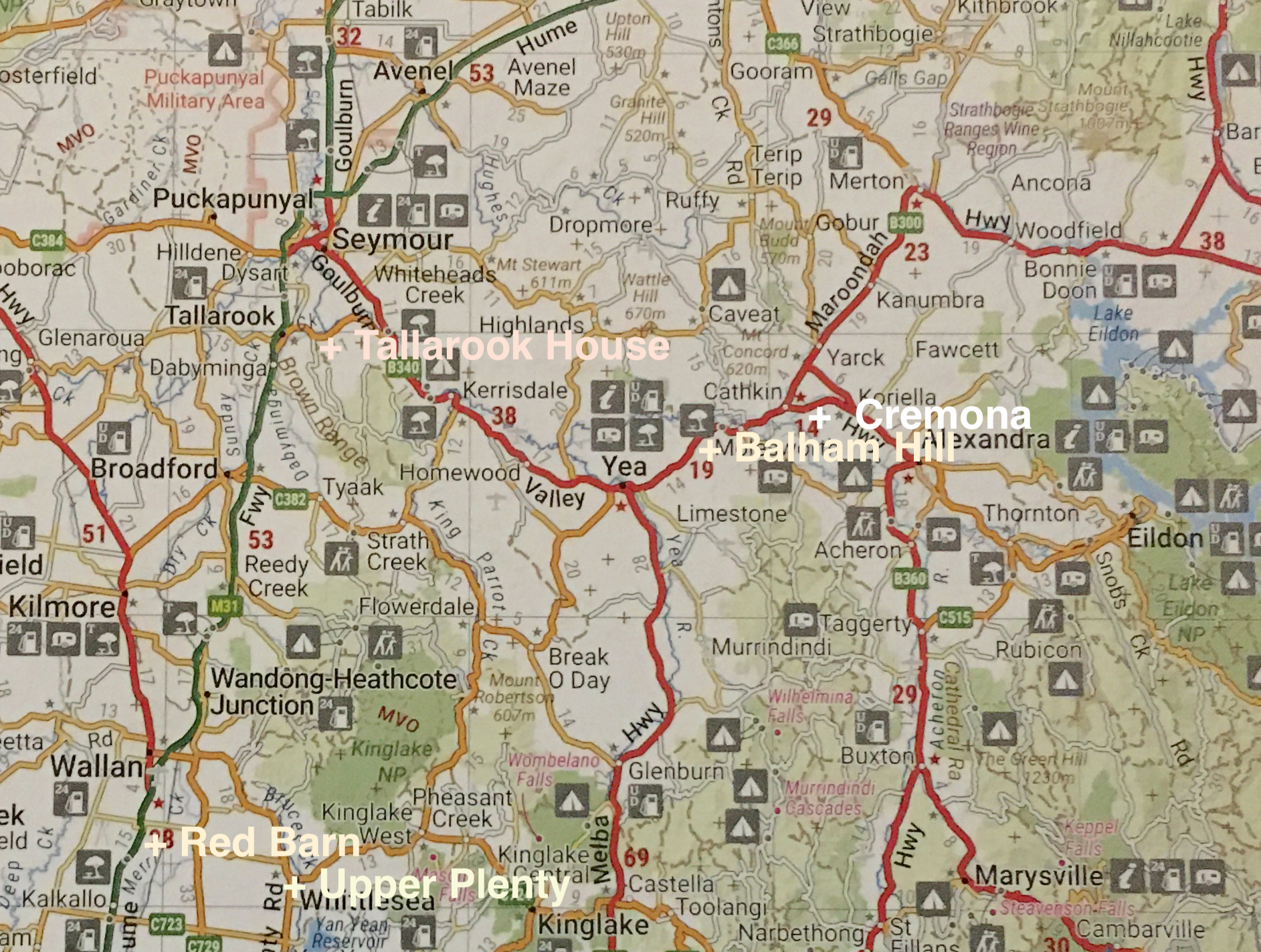
It took weeks to piece together the snippets of information we had. We doubled checked information, discarded red herrings, created a timeline. We complained about the way names appeared and reappeared in different generations. We cut and pasted a colour coded chart. Finally, gradually, the stories came into focus in our minds.
Our story begins in Ireland.
Four families: McCormacks, Fords, Hamiltons and Ryans
Three of the families, the McCormacks. the Fords and the Ryans, all Catholics, all emigrated about 1848 from Southern Ireland: Limerick, Galway and Tipperary
The fourth family, the Hamiltons, were protestants, of Scottish Irish heritage. They emigrated from Antrim, Northern Ireland, also in 1848.
The Northern Irish Hamiltons arrived with some money, ready to buy land. But
our Southern IrIsh were probably driven out by the general economic turmoil and devastation caused by the Irish Potato Famine of 1845-1852.
At that time, the vast majority of the Irish Catholic population had little or no access to land ownership and many lived in appalling poverty.
Ninety percent of the land in Ireland was owned by Protestant landowners, who rented it out in small parcels to Irish tenant farmers. Already poor and dependent on the potato crop, Irish families starved when successive harvests failed, due to Potato Blight. As a result, Irish people emigrated in large numbers, land hungry and ready to and make their fortunes.
The colony the McCormacks, Fords, Hamiltons and Ryans arrived and settled in, had been ‘opened up’ by the squatters coming down from north of the Murray and inland from Portland. The Aboriginal tribes had been largely dispossessed, vast fortunes had been made, and the landed aristocracy had emerged as a powerful force in the burgeoning colony.
It is both expected and fascinating to see our Irish immigrant forbears’ land acquisition and prosperity mirrored, in the opening up of land for settlement in Victoria. This took place over several decades, primarily through a series of land acts, designed to break up the vast holdings of the squatters and encourage agricultural development, population growth, and the establishment of communities.
Between 1865 and 1890 Land Acts enabled land to be acquired at a fair price, and paid off in instalments. Specified improvements had to be made such as fencing, clearing and cultivation.
As we will see, our Irish families also benefitted from the growth and prosperity stemming from the Gold Rush. In 1851 gold was discovered in Ballarat, leading to the 1850s Gold Rush, a transformative event in Victorian history.
The colony grew rapidly in both population and economic power and our families, among others, took full advantage of the opportunities offered.
They set about the serious business of acquiring property supplying the new, lucrative, growing market with their produce. Country towns around them grew and with increased wealth, substantial civic buildings and churches were built. Railways and roads were constructed providing quicker and easier access to markets and facilitating social and family connections.
It would have been an exciting time for our four families, as they bought and developed their land holdings and participated in the civic life of the Colony of Victoria, with its own Lieutenant-Governor and elected Victorian Legislative Council.
During the first fifteen years after arriving in the colony, our four Irish Families became two couples.
1 James Hamilton and Bridget Ryan
The protestant Hamilton family from Northern Ireland comprised only a mother and son. We know that James Hamilton’s father had recently died. James was in his late teens, when he and his mother emigrated to Port Phillip, with enough capital to acquire a property in the colony. They chose Upper Plenty, which at that time was a rural area.
The Ryan family also emigrated about 1848.
About seven years later, in 1855, James Hamilton married Bridget Ryan. Bridget was a Catholic. Sue and I know something of this quandary, being daughters of a similar “mixed marriage”. The wedding was held on a property “Richland” near the Hamilton’s place at Upper Plenty. The property belonged to Mr David Johnston
Archbishop Little, who is also related to these four families and has written about them, has a bit to say about this marriage:
“… the marriage of James and Bridget was a truly valid Catholic marriage in the eyes of the Church.”
What he means here is that James would have agreed to the children of the marriage being brought up Catholics. He certainly followed through with this, even driving his wife and children to church on Sundays. Two of their daughters later became nuns.
James and Bridget stayed on for a further twelve years in Upper Plenty, where the first six of their children were born. These children included Charles, Grace, Johanna and Kate. Johanna was our Great Grandmother.
Then, in 1866, they acquired “Cremona Estate”, near present day Molesworth. They ran dairy and beef cattle and grew cereals on the rich
river flats.
Cremona homestead was "situated on the southern concave side of a great sweeping arc of the Goulburn river ….. it fronts the Whanregarwen road distant some three miles east from the present township of Molesworth" 1866:

Six further children, another five of them girls, were born at Cremona, before Bridget’s death, at the age of 56, in 1889.
Archbishop Little writes glowingly of life at Cremona, and of the three eldest Hamilton girls in particular. He describes them as “charming, refined, eligible and capable young ladies.” He describes the children’s education. An in-house private tutor taught them Art, Music and Painting, as well as academic subjects. But they all helped out on the farm as well, including the older girls, Grace, Johanna and Kate.
2 John McCormack Snr and Jane Ford
We don’t know the initial activities of the McCormack and Ford families, until, in 1850, two years after landing in Port Phillip, John McCormack (Senior) married Jane Ford at St Francis Church on the corner of Lonsdale and Elizabeth streets in Melbourne. Both had been in their late twenties and unmarried when they emigrated.
St Francis church today, the oldest still operating Catholic church in Victoria:

The couple settled near present day Beveridge, renting a property “Red Barn”. The property was very near the main road from Melbourne to Sydney. The family worked hard and developed a dairy herd, specialising in cheese, which they initially sold to passing diggers on their way to the goldfields.
Red Barn Lane today:

There was money to be made, so much, that the couple were later able to settle their sons on properties along the Goulburn River.
The first, of these, in 1876, was the eldest, James McCormack, then aged 18. His property, called Tallarook House, (later renamed Landscape), was at Tallarook, a hundred kilometres from Mebourne. James was unmarried at this stage and Tallarook House remained without a mistress for a further twelve years. Clearly, James was very involved in the community. He was elected as a councillor for the Shire of Seymour in 1887.
"Landscape" today:

"Landscape" interior:

The second McCormack to be settled along the Goulburn River, was John Jnr. His property, acquired in 1886, called Balham Hill, was near Molesworth. He also became a councillor, for Yea Shire.
Balham Hill:

Balham Hill property:

The Big Romance
So now we have three properties along the Goulburn. James and Bridget Hamilton’s Cremona and John McCormack’s Balham Hill, both near Molesworth, and James McCormack’s Tallarook House, twelve miles away.
The Hamilton girls, Grace, Johanna and Kate probably had met the McCormack boys, James, John Jnr and their brother Michael, at church. They were all Catholics.
The Hamiltons and McCormacks were a natural social fit: all pasturalists and Catholics of Irish extraction.
Archbishop Little tells us that the “Hamilton girls” stabled their horses at Tallarook House when catching or meeting the trains, and “made eyes at the McCormack boys”.
The roads between the Upper Goulburn and the railhead at Tallarook, had been completed by 1880, and the railway from Tallarook to Yea was being built from 1883. So we suppose that the road from the Upper Goulburn to Tallarook would have been a substantial one, about the time the girls were using it. Tallarook was where farm produce, etc was taken to put on the train for the markets in Melbourne.
But it’s a long way from Molesworth to Tallarook. Were they driven in a carriage of some sort, accompanied by workers from Cremona? Did they ride their own horses all that way? It was too far for a day trip. Where did they stay? And had the Hamilton girls’ parents met the McCormack boys’ parents, who lived quite a long way away, at Beveridge?
It’s a love story we can only speculate about.
But, ultimately, three Hamilton girls married three McCormack boys.
The most important to us, was Johanna Hamilton, our great grandmother, who married John McCormack Jnr of Balham Hill, in 1888.
Her sister, Grace, married James McCormack of Tallarook House in 1890
And Kate was the third sister, who married Michael McCormack. They settled initially in Berwick, and later Benalla.

Women's Work
Like women throughout history, most of the women in our family have had the primary job of parent and homemaker. Those homes range from simple pioneer cottages to majestic residences with grand staircases and sweeping verandahs. Nearly all of those women have also done paid work. And some of those who have not been specifically employed, have had supporting roles in their husband’s careers. Some jobs have been done by different family members across different generations.
None of our women have had traditional men’s careers, but, across the generations, we have covered a wide range:
AGRICULTURE (Dairy maid, Famers’ wives)
HEALTHWORK (Doctors’ wives, Aide, Occupational Therapy Assistant)
HOSPITALITY/TOURISM (Publican, Office Administraion, Horse Trail Guide)
RELIGIOUS SERVICE (Lay Preaching and other good works, Nun)
ADMINISTRATION (Postmistress, Sales Administration Supervisor, Office Administrator)
THE ARTS/CRAFT/DRAFTING (Whitework, Semco and Dressmaking, Drafting and Drawing Office, Drafting, Drawing and Card production, Art and Craft Activities for At Risk Children, Set Design and Construction, An Artist in the Hills)
RETAIL (Grocer, Checkout Chick)
SCIENCE (Laboratory Work)
EDUCATION (Teacher)
AGRICULTURE
Dairy Maid
Our paternal great, great grandmother, Catherine Bourke, née Kelly, worked as a dairy maid in Limerick before marrying Michael Bourke, and emigrating to Australia, in 1839. When they arrived in Melbourne, their first job was managing a dairy farm in Moonee Ponds. Catherine’s knowledge and skills no doubt influenced this decision.
The “famers’ wives”
A recent (2022) Guardian article tells us that, until 1994, women could not list “farmer” as their occupation on the census form. Instead they were viewed as “non-productive silent partners”. Even today, when 49% of real farm income is contributed by women, our image of an Australian farmer is almost entirely male. This puts “farmers’ wife” in this exploration in a particular light.
Another interesting aspect of these women from our family history is the divide between the wealthy squatters and the ordinary people of the land.
Martha Rye, the “poor little thing”, whose story we told in the June 2016 post, was a “farmer’s wife”, as was her mother, Elizabeth. Both of these women had very large families.
Elizabeth, our great great great grandmother, had eleven children. We can work out quite a bit about Elizabeth from a newspaper story, written about her husband, Adam’s life. She had worked in service, as a housekeeper, before she and Adam emigrated to Australia, in 1848. She could read, but not write.
They grew potatoes and onions, first on a rented farm near Geelong, then on two acres in Broadmeadows. The whole family would have been involved in the farm work, especially at harvest and market times.
We know that Adam not only worked as a labourer on neighbouring farms, but also spent time away trying his luck on the goldfields. It would have fallen on Elizabeth and the children to keep things going on the farm.
Martha, Elizabeth’s daughter, was married to Joachim. They would have had long days on the dairy farm, Heather Farm, near Kilmore. We learned a bit about her from her daughter Sarah, born in 1866. We wrote about this in August 2016. Sarah wrote with sentimental nostalgia about milking the cows, Blossom, Peggy and Strawberry; feeding poddy calves; working the separator; and rearing seventeen children. But between the lines, one can see the massive workload.
Around the same time, our paternal great great grandparents, John and Johanna McCormack, bought their 15,000 acre grazing property, Balham Hill, fifty kilometres to the west. So, in a sense, Johanna was also a “farmer’s wife”. But what a different life! John, a Justice of the Peace, and community leader, had staff to attend to the farm. Their four surviving children all went to boarding school in the city, for their secondary education.
John’s father, also called John McCormack had also been a wealthy grazier. His wife, Grace, lived there at the property “Landscape”, at Tallarook, until her death aged 83. I doubt she would have thought of herself as a “farmer’s wife”.
Two generations on, Johanna’s granddaughter, our Auntie Tish, also married a farmer, near Warrnambool. Matt Rae was probably more of a hands on farmer than John McCormick, but he, too, was considered a grazier, and Tish’s life did not run to milking cows and feeding poddy calves.
Around 1950, close to the time Tish became a “farmer’s wife”, our mother’s aunt, Beat, and her husband Bill, sold their Surrey Hills grocery and bought land for a dairy farm in Cockatoo. The activities on this farm were similar to those at Heather Farm, a hundred years earlier: milking, feeding calves, working the separator. The difference in their lives is technological. An electric milking machine and separator, tractors, hay bailers, meant that they ran a dozen cows instead of three. And they had three grown children instead of seventeen. Nevertheless, they all had to work hard to make the farm pay enough to support them all. We wrote in detail, in our November 2017 post, about our childhood visits to this farm. There we described Beat’s pigs. This was her major farming contribution. She was not just a “farmer’s wife”, but actively involved in the decision making and physical work of the farm.
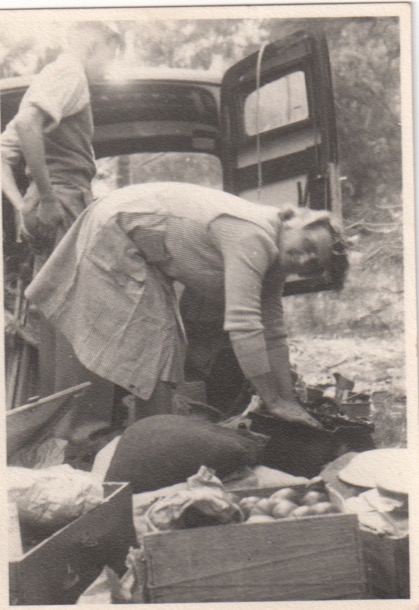
Auntie Beat
HEALTHWORK
Health work does not feature much among the women in our family. there are no doctors or nurses, that we know of.
Doctors’ wives
Our grandmother, Grace, and her daughter, Joan, were “Doctor’s Wives”. Wealthy, well connected, pillars of society, these women had no real job. In both cases, their husband’s surgery was within their house, but they were not required to deal with actual patients.
Among the women in our family, there are a few cases of unskilled health work.
Aide
Like so many women, our mother, Alice, “went back to work” when her youngest child was about ten years old, in 1966.
The only job she had had, since leaving school aged seventeen, was the wartime munitions work she had done at Maribynong, which today would have been called Lab Technician.
What skills did she have to draw on, apart from housework and parenting?
So her job as an “aide” at Lady Herring Spastic Centre was a low paid, unskilled one. She was assigned, with one other carer, to a “class” of Cerebral Palsied kids roughly the same age, none of whom had the ability to speak, and many of whom could not feed themselves. This was before the days of Communication Boards, so even the most able kids could not communicate much.
I, too, had a job at Lady Herring, after I finished school, and before I began the university year.
The centre was in Malvern, and Alice, and I, for the few weeks I was there, travelled by tram, along a very familiar route, down Riversdale Road.
There were a few qualified staff at the centre, physiotherapists, occupational therapists, but the program, such as it was, seemed to be up to people like Alice to devise. With the exception of the bus drivers, the whole staff, including the boss, was female.
The kids commuted on a special bus, and spent the whole day at the centre. Much of the time was filled with dealing with their physical needs, but there were excursions, shopping trips, walks around the neighbourhood, music sessions, and a memorable overnight “camp”. Although low status and poorly paid, it was stimulating, challenging work.
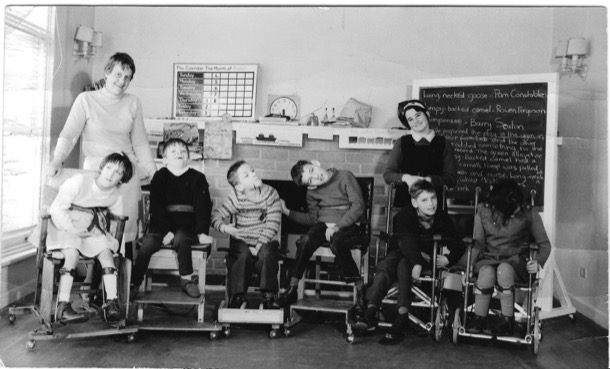
Alice with her "class"
Occupational Therapy Assistant
On the strength of my experience at Lady Herring, I did two other holiday stints as an OT assistant.
I worked with our OT friend Rikki, at Fairfield Infectious Diseases hospital for a little while. This was before HIV made it such an important place. My memories of Fairfield include the beautiful historic buildings; dozens of beds in a row, in the children’s Hepatitis ward; and the iron lung ward: people who had contracted polio as children and spent their life lying inside huge metal chambers that helped them breathe.
My job was mostly helping tidy up the activity room, and working in the ward with the Hepatitis kids: mostly bringing them things to do.

Fairfield Infectious Diseases Hospital
And then, during another long uni holiday, I worked at Montefiore (Jewish) Aged Care in St Kilda. It was perhaps 1970. Most of the Occupational Therapy “workers” there were volunteers: generally well off middle aged Jewish women doing their bit.One of those volunteers, who I remembered just as Mrs Hayman, later became Sue’s mother in law.
In my memory, the whole staff, except the doctors, were women.
In our centre, where the patients came to us, we ran activities like singalongs, bingo, games etc.
Many of our patients were post war immigrants from Europe, and some had been in Nazi concentration camps. It was the year that Melbourne emergency vehicles changed from sirens to “nee naw nee naw”, the same sound the SS vehicles had used in wartime Europe. When we heard the distant sounds approaching along St Kilda Road, we needed to be aware of some patients’ reaction.
I remember being told that that gentleman with his trousers barely held up with string, had been one of Melbourne’s top barristers. I still have the book called “Favourite Jewish Songs”, piano accompaniments I used for the singalongs I accompanied.
HOSPITALITY/TOURISM
Publican
Catherine Bourke, in her new home near Pakenham from 1844, helped with the establishment of Minton’s Creek Run, the farm in the Toomuc Valley, that they bought with another family. But in 1850, they bought the Latrobe Inn, on the main Gippsland Road, in current day Pakenham. Catherine moved out of the slab hut up the Valley, with her seven children, and became a publican. The inn became known as Bourke’s Hotel. Michael was still very involved with the family, and they had another eight children, but it was Catherine who ran the hotel.
As well as a stopping place for travellers, Bourke’s hotel was the local post office, and a hub for the community.
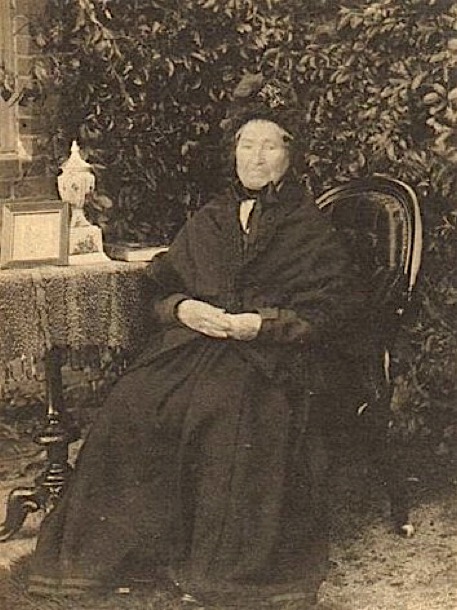
Catherine Bourke
Horse Trail Guide
Catherine’s great, great, great, great, great niece Eliza, one hundred and seventy years later, also moved to the country to start a new job in tourism. Seeking a change from office work, Eliza moved to Mansfield to work for Hidden Trails by Horseback. This company runs trails in the Victorian High Country and also at El Questro Station in the Kimberly.
In Eliza’s own words her job entailed the following:
Up at the crack of dawn. Run the horses in. Feed the ones we are working that day. Brush and saddle the horses needed for the rides.
Determine the guests riding experience, match to a horse. Sign indemnity forms, Go through basics (stop start turn etc) and then lead the ride out, float in the middle of a big group, or tail the group at the back.
We go out on four rides a day:
*AM 2 hour ride (around the station)
*Kids intro ride (around the paddock)
*1 hour loop (around a different part of the station which includes the deep moonshine creek crossing)
*PM 2 hour ride (incorporation of the 1 hour loop with a look out stop where we would take a pack horse with drinks and nibbles and tie the horses up and have a sit down)
In between those rides we feed lunch to the horses working. Then back to the stables in the afternoon, Unsaddle, wash down and tip out the horses. And then do it all again the next day. Shuffling them around in different paddocks so we could keep them all in work.
There was 40 horses total.
Long days. Great experience.
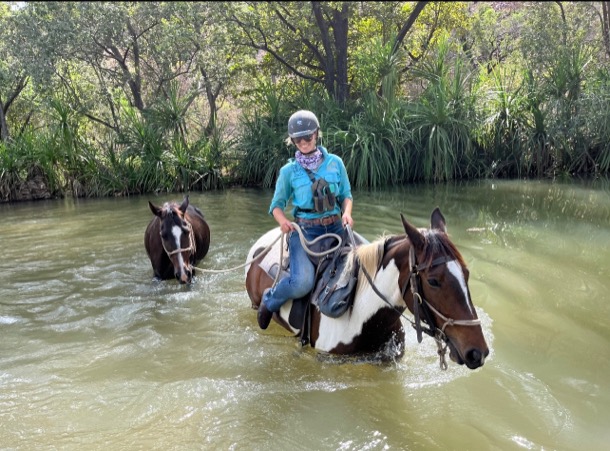
Eliza at El Questro
RELIGIOUS SERVICE
Lay Preaching and other good works
Both our mother Alice and her maternal grandmother Emma Coates (née Dau) were staunch protestants and indulged in a little lay preaching and good works.
Emma Dau, one of seventeen children, was married to Alfred Coates, who was a Wesleyan Methodist Pastor. Emma’s married life consisted of raising a family, and her duties as the Pastor’s wife. Family stories tell of her devotion to these duties and of her riding around the parish on a push bike.
At some stage in her life, when our mother was still a child, Emma also became a Home Mission Sister and was known as Sister Bessie. As a Home Mission Sister, Emma wore an impressive uniform, that is described vividly by our mother and Auntie Marge, who as children were very impressed by this formidable woman. Here they are discussing her:

Sister Bessie
Sister Bessie worked at the Methodist Home Mission in Brunswick Street Fitzroy, in the 1920s and 30s. Sister Bessie’s work with the ‘fallen women’ and the poor, in the slums of Fitzroy was also vividly remembered by Marge and Alice. Sister Bessie’s good works involved anything from delivering babies to rescuing unmarried mothers. All of this was carried out ‘in the slums’ and in ‘poor, dirty houses’. One story has it that Sister Bessie once took off her own petticoat to give to a poor woman who did not have enough clothing.
The slums of Fitzroy were indeed slums, with a reputation for dirt, filth, disease and crime, a fearsome place. Streets were unpaved, there was no running water in many of the crowded and small weatherboard houses and children often ran barefoot.
So bad were the Fitzroy slums, that in the 1950’s they were demolished and the population was moved to the Housing Commission Towers, still standing in Brunswick Street.

Slums in Melbourne
Sister Bessie also travelled within Victoria and Tasmania. She was lay preaching, called ‘deputation work’ and raising money for the Home Mission. Apparently she was a very good story teller and must have not only impressed her young grand daughters but also her audiences, as she regaled them with stories from ‘the slums’. So impressed was one small child, that she gave up her doll ,to be given to the poor children who had no toys.
Half a century later Alice stood in her grandmother’s shoes at the same pulpit of a small, now Uniting Church, at Jung in the Wimmera.
Alice was also doing ‘deputation work’ in a fashion, preaching about world poverty and inequality. She was also raising money for the Uniting Church’s fight against poverty. Alice mentioned that her grandmother, Sister Bessie, may also have preached here. Incredibly a member of the congregation remembered as a small child listening to Sister Bessie preaching and telling stories. She said,“She was a wonderful story teller.”
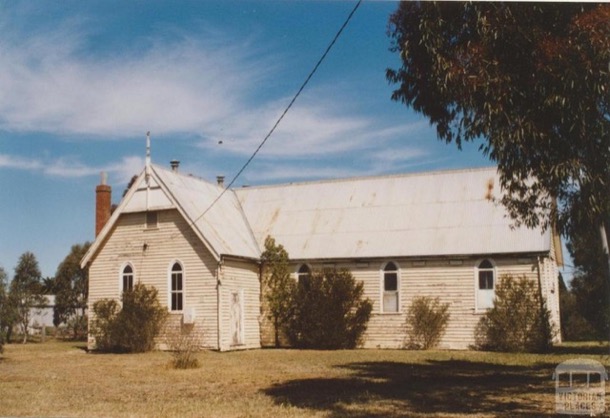
Jung Methodist Church
The Nun
We grew up with stories of a nun in the family but knew no details. With the assistance of Google, we now know that Frances Bourke, [1883-1964] Jim’s Great Aunt, joined the Presentation Sisters, probably as a young woman, and became Sister Magdalen.
Presentation Convent was founded in Windsor in 1873 ,after a request by the Parish Priest for sorely needed teaching staff at St Mary’s school.
We are intrigued about Sister Magdalen and her role. Was she a teaching Sister or did she have another role at the Windsor Convent? Did she spend her life in the Order? Watch this space, hopefully more to come.
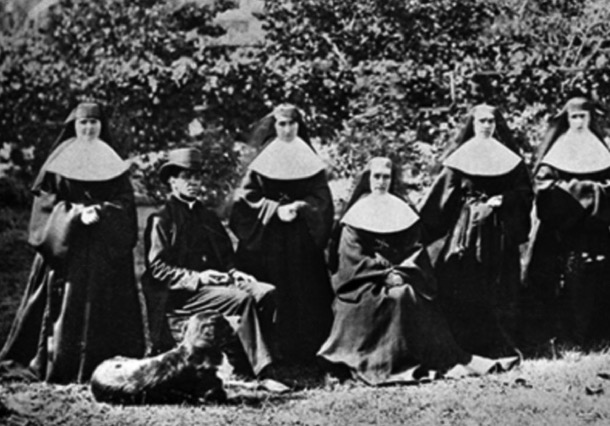
Presentation Sisters
ADMINISTRATION
Administration is part of many jobs, often the least pleasant part; writing reports, managing co workers, attending meetings, communication, ordering supplies, keeping records. These tasks are familiar to many workers.
Postmistress
In 1859 Bourke’s Hotel in Pakenham also became the community post office, ten years after Michael had bought the license. He became the founding post master of Pakenham. After his death, in 1877, Catherine became the Pakenham postmistress.
Up until 1901, each of the colonies operated their own postal service. After Federation, they all merged to become the Postmaster Generals Department (PMG).
Cecelia,(Cissy), Catherine’s youngest child, who never married, continued the role after Catherine’s death in 1910.
The job of postmistress would have involved taking sacks of mail to and from the Cobb and Co coach, later the train, and sorting it for people, who would come in to collect their mail.
Over time, the job of post mistress also included a savings’ bank, money order office and telegraph station; quite an important role in the local community.
Sales Administration Supervisor
But for a proper administration job, Tessa is our woman. Her job at Kenworth Trucks is to project manage the outfitting of each truck. She manages a team of people who put 22 trucks per day together, to the specifications of each customer. Keeping all the balls in the air, making sure everyone is gainfully employed, smoothing relationships with customers and between workers, maintaining records, supervising departments. It’s a very large and stressful job.
Office Administrator
Another organised young woman is Eliza who has also worked in office administration, at Nautilus Training and Curriculum, the company founded by her dad, Ian.
THE ARTS/CRAFT/DRAFTING
Whitework, Semco and Dressmaking
Three of our women worked in the textile industry, a generation apart. Both Great Aunts Bert and Beat and our Auntie Marge were involved in the embellishment of textiles with embroidery, and in dressmaking.
In our post on Auntie Bert, ‘A Sterling Character’, in March 2019 we explored ‘Whitework’. Whitework embroidery is the general term for hand embroidery worked with white thread on white fabric. It was used on many household items from babies’ bibs and tea towels to under clothes. Bert and Beat who, as young women, worked in this industry, probably worked in Flinders Lane. At this time it was the centre of the “rag trade”.
Auntie Bert, being unmarried, needed to continue in the workforce, but also be available to help her elderly parents with whom she lived. A talented and resourceful woman, she started a dressmaking business, working from home. Although self taught, her reputation for fine tailoring and expertly fitted ladies’ wear soon spread amongst the ladies of Camberwell and Surrey Hills. As her clientele increased and business grew, she had to move to bigger premises, and Bert leased space for a workroom and office in Riversdale Road Camberwell. This business is also described in our post ‘ A Sterling Character”
Drafting and Drawing Office
Our Auntie Marge worked in a number of drafting and drawing offices during her working life. After her short stint teaching, Marge began work in a drawing office in Collins Street, and then, during the war, moved to the drawing office at Maribyrnong Munitions Factory where Alice also worked. In 1941 Marge moved again, this time to the drawing office at ICI.
Later in life, Marge used her artistic talents at Semco, designing patterns for embroidery transfers. The designs were created as line drawings and printed onto tissue paper transfers, to be sold to women to embroider for items for the home, or as gifts. The transfers were ironed onto cloth after which the item could be embroidered accurately following the design. Margaret and I can remember embarking on an Semco embroidery project that I don’t think we finished.
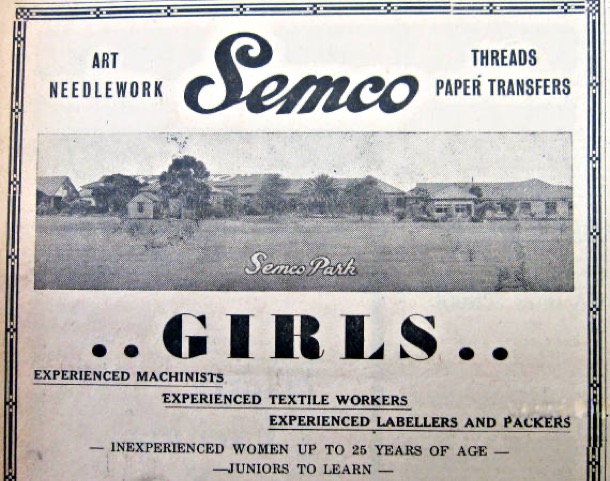
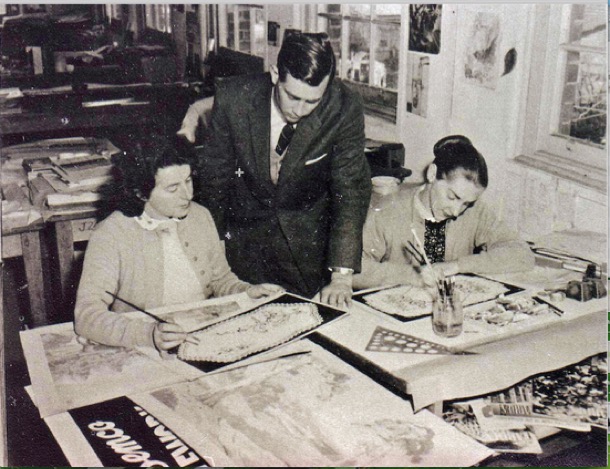
Semco Workroom
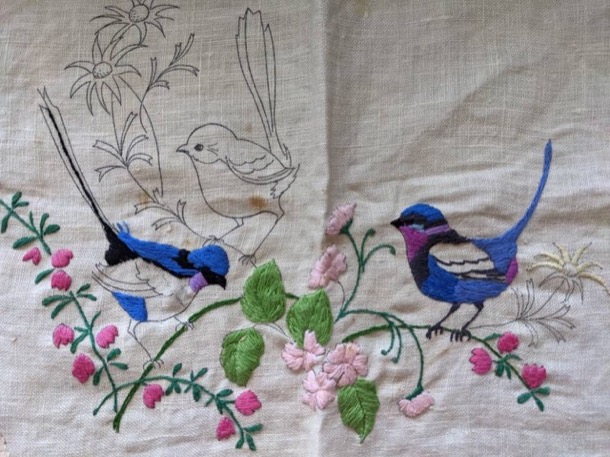
Typical Semco Embroidery
Designs subjects were flowers and animals, both European and Australian, cute houses, toys and even landscape scenes. Amongst the many items destined for embroidery were doilies, tablecloths and serviettes, tray cloths ,handkerchiefs, babies’ outfits and children’s clothing.
Margaret and I can also remember visiting Auntie Marge at Black Rock and seeing her designs on a big drawing board. A working mother was a novelty for us, as our mother did not work outside the home.
The Semco factory and workshops located in Semco Park, Black Rock, was quite a progressive company and treated its employees well. They paid award wages to women, and provided recreation facilities for the staff, including six and a half acres of garden and lawn for their enjoyment. It was a large employer, as not only were the designs created and printed, but the embroidery cottons were also spun and dyed.
Marge worked for Semco as a part time employee, and at the same time studied Interior Design at RMIT. Both were unusual. For many women of her era, part time work outside the home was difficult to find, even once children were at school. Marge was fortunate to have Semco in her area and for it to be accessible on public transport. This allowed her to work there for many years, while pursuing her life long interest in further study.
Drafting, Drawing and Card production
Marge worked in a number of drafting and drawing offices during her working life. After her short stint teaching, Marge began work in a drawing office in Collins Street and then, during the war, moved to the drawing office at Maribyrnong Munitions Factory where Alice also worked. In 1941 Marge moved again, this time to the drawing office at ICI.
In between jobs outside the home Marge, like her Aunt Bert, started a business from home. Using her artistic skills and her design experience at Semco, Marge launched a greeting card business. She designed and screen printed the cards, packaged them and sold them to shops specialising in handmade original work.
Art and Craft Activities for At Risk Children
From this heading, it is obvious that this position could be fraught with difficulties. As a nineteen year old I was blissfully unaware of the worlds these children came from. Orana was a Uniting Church children’s home for at risk children and ‘orphans’. I remember mostly a group of cardigan and jumper clad children in skirts and shorts, traipsing into a linoleum floored space to participate in whatever I decided to do. I don’t remember anyone checking the activities, or that I had to run them past any of the staff. Some of the activities were very, very messy, but the children willingly helped me clean up. The confronting and difficult part of this job was not the behaviour of the children, but the heavy prevailing air of sadness in that place.
Set Design and Construction
Lois learnt woodworking from her dad. Together with her design and craft skills, she developed her “Top Props” business, designing and creating stage props. For instance, Deirdre’s Tappers’ concerts would not have been the amazing spectacle they were, without Lois’s colourful props.
An Artist in the Hills
Through her meticulous fine drawings and paintings Katherine explores a fantasy world inhabited by little creatures and characters, who are at home with spiderwebs and toadstools or nestled under gnarled old trees . Working from her house and studio in the Dandenongs, she is pursuing her interest in children’s book illustration.
RETAIL
Grocer
Our Great Aunt, our grandmother’s sister, Beatrice Morris (nee: Holm) owned a grocer’s shop in Maling Road, Canterbury, for a number of years. Bill Morris had previously worked at Lawson’s Grocer in Middle Camberwell , so having experience, this was a logical move. We are not sure how long they were in Maling Road but presumably Auntie Beat helped in the shop as well as raising a family of three boys. It must have been reasonably profitable, as during this time they built a house in Balwyn, and then sold the business to buy the farm, Sefton Park.
“Checkout Chick”
Anna, Beatrice’s great, great niece, is the only other woman in the family who has worked in retail, and this too was in grocery shop: the Renaissance Supermarket, Hawthorn, in the 1990’s: it was a supermarket of course. At sixteen Anna was keen to have a part time job and earn her own money. Her position was ‘checkout chick’, working on the register, before scanning of prices using barcodes was all entirely automatic. For instance, the checkout chicks had to memorise the PLU code for all the individual fruit and vegetable items, and this had to be entered on the register, manually.
SCIENCE
Laboratory Work
After the horrific use of chemical warfare (gas), on the European battlefields during the 1914-18 war, many countries began to work on ways to protect their populations from gas warfare.
Australia began its own “Chemical Defence” research program in 1926 at the Munitions Supply Laboratories, in conjunction with Melbourne Uni. They developed and assembled “respirators”.
By the time the second world war began in 1939, scientists were well advanced in this work. In 1940, over half a million respirators were manufactured at Maribyrnong Munitions Factory, and more than 500 people were employed there.
Our mother, Alice worked there, in the microscope section, testing the penetration of gas that came through the filters. When she would describe this work, she would indicate tapping and counting as she stared down the microscope. She had studied Year 11 Chemistry the year before she started.
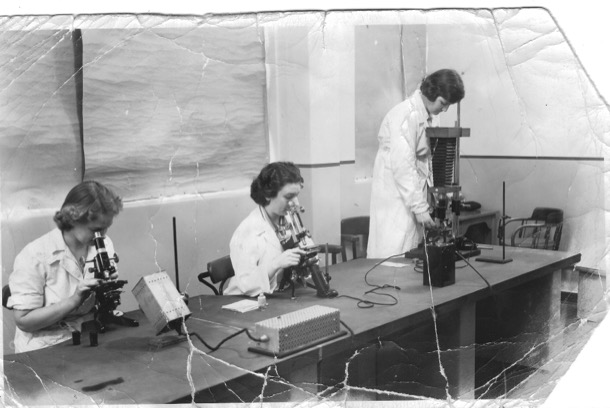
Alice, left, working at Maribrynong
EDUCATION
Teachers
At least five of the women, in four generations of our family, have been teachers, some primary, some secondary.
The earliest we know of is our Nana, Alfreda, who taught primary school, before marrying Alfred in 1916.
She had fought for a chance to continue her education after secondary school. There was not enough money for university, and so she went to Melbourne Continuation School, which later became Melbourne High School. Its focus was teacher training and thus, after two years, Alfreda became a teacher. Presumably she taught for about four years. Women had to resign from teaching when they married.
Our Auntie Marge, Alfreda’s eldest daughter worked as a teacher for a year, straight from school. She taught 50 five year olds at Balwyn North, as a “junior teacher’. She also went to RMIT three nights a week dong Fine Art, her real passion. She only lasted one year, having decided that she was not suited to teaching. Our mother, Alice, while not actually teaching, worked as a school librarian assistant for the last years leading up to her retirement.
The next generation is ours, and at least four of us worked as secondary teachers: Pauline for a few years, and Sue, Anne and I until our retirements. All three of us did our initial tertiary education, including teacher training, on “Studentships”, which provided free education and a small wage, in return for three years service, usually in the country. Sue went to Sale, Pauline to Portland, and Margaret to Moe. Sue and and I wrote about our first year teaching experiences in a post on October 28, 2015, filed under “Young Adults 1970s”

Sale High School
Of our own daughters and nieces, only Anna has taken on the mantle of teaching. She even completed most of a PHD in Education. Recently, in her mid forties, she has gone back to the English classroom in a secondary school, where she is thriving!
Such a lot of different job experiences, and yet, within relatively narrow parameters. No astronauts, truck drivers or plumbers.
And, it must be stressed, the most important job for almost all these women, over six generations and nearly a century, is that of parent and homemaker.
The Built Environment - Hawthorn
30 07 19 15:36 Filed in: Jim
Our forebears have been part Melbourne since the 1850s. They came from Europe, Ireland and Great Britain, arriving at the Port of Melbourne, to make a new life. They found a raw, settlement, recently carved from the Wurundjeri lands: a settlement coping with sewerage, ad hoc development and the pollution of emerging industry along the river. The punt, at Punt Road, provided access across the Yarra that occasionally broke its banks and inundated the new city streets. From this frontier town the newcomers moved out into the country to make their fortunes and raise families. Some of their descendants, our extended family, remain in country Victoria but many, over the generations have made their lives here and left traces in the built environment of Melbourne.
These posts can be viewed as a virtual pilgrimage of the structures and buildings in Melbourne and how they relate to our family. Melbourne is undergoing a tumultuous time of change, as, in 2019, its population grows to nearly five million. Our family landmarks are inevitably caught up in the changes too, as you will see.
Our first post covers the suburb of Hawthorn.

Glenferrie Road
733 Glenferrie Road is listed on the Glenferrie Road Historic walk as the ‘historic mansion Toolangi. It was built in1905 as a doctor's surgery and residence for William Clayton, physician and surgeon.’
This house is significant to our family as two generations of Bourke doctors lived and worked here and our father spent his teenage years here.

It was in the late 1930s that our paternal grandfather Dr. Hugh Bourke and family moved to Glenferrie Road from Koroit. Presumably Grandfather Bourke bought both the property and the medical practice.
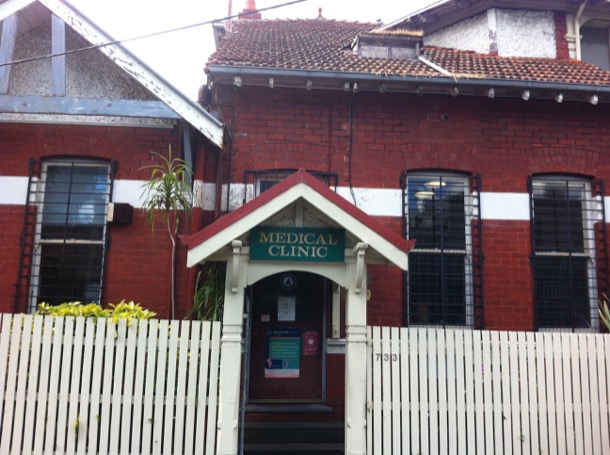
At this time, our father was at secondary school at Xavier, where he had boarded until the move. He continued to live in the Glenferrie Road house until he was married in 1945.
After Grandpa Bourke’s death in 1950, Grandma Bourke moved out and Dad’s brother Jack and his family moved into the house. Jack took over the practice, which he ran until he retired.
I have clear memories of the house, both visiting Uncle Jack and, once or twice, the surgery. The house seemed enormous and imposing, and as we mentioned in a previous post, the paraphernalia of Roman Catholicism was very evident. Uncle Jack also had a greenhouse in the back garden where he grew orchids and Christmas Lilies. The garden shed and the greenhouse where still there until recently.
I still associate the perfume of Christmas Lilies with visits to Grandma Bourke at Christmas.
The building next door to Toolangi was the Hawthorn Motor Garage, built in 1912 . From the 1920s the garage was run by Albert James Kane and family, who had it for 20 to 30 years. They introduced the first electric petrol pump in Hawthorn.

The Hawthorn Motor Garage building is on the Victorian Heritage Register. It is the oldest known purpose-built motor garage in Victoria. Dad would have been very familiar with the Kanes and the garage: while courting our mother, he was lucky enough to be able to borrow his father’s car and use his petrol coupons to fill up at the garage next door. As it was wartime, petrol was strictly rationed but doctors received extra coupons, that Dr. Hugh obviously allowed his son to use.
In April 2019, when we visited it, the site of the house and the garage were in the process of being redeveloped. The garden and out buildings have been cleared away but the main structures of the Hawthorn Motor Garage and Toolangi remain. They will be repurposed as part of the new apartment complex being built on this corner.

At the other end of Glenferrie Road shops is the Catholic Church. An imposing bluestone structure, the Church of the Immaculate Conception still dominates this busy corner. The Bourke family would have attended Mass here every Sunday. Now I walk past here every six weeks on my way to have my hair cut. Time marches on.
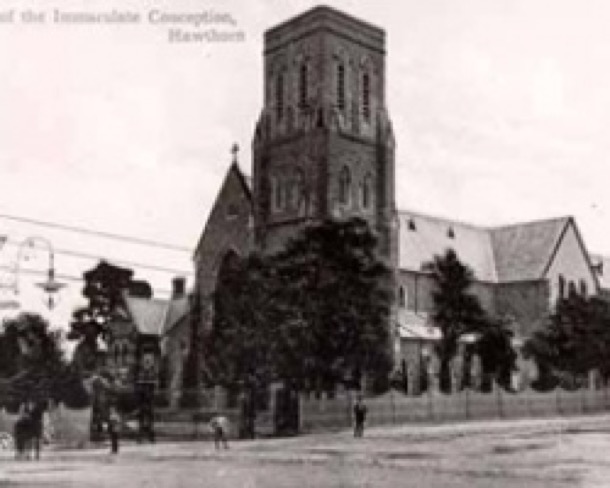
Urquart Street
After our grandfather Hugh’s death in 1950, Grandma Bourke moved a few streets away to Urquhart Street, still in Hawthorn, leaving Jack to bring up his family and run his practice from the Glenferrie Road house.
We remember this house well. Grandma Bourke was a keen gardener whose beautiful roses and bulbs were fertilised by the manure from our parents’ chooks. A huge weeping deciduous tree in the front yard afforded a play area for visiting grandchildren. The house was big enough for our aunt and family, who lived near Warrnambool, to stay over Christmas.
It had a coal cellar, accessed by a trapdoor on the back verandah, with fed the coke heater.

The house looks much the same in 2019, as it did sixty years ago, when Grandma served cake and tea in beautiful china in the front room to her visitors, and mugs of tea with slabs of bread and butter to workmen on the back verandah.
Xavier College
Our uncle and father, first went as borders to Xavier College for their secondary eduction. When our father began there in 1932, Xavier had already been there for fifty years. It was and still is, the premier Catholic Boys private school in Melbourne.
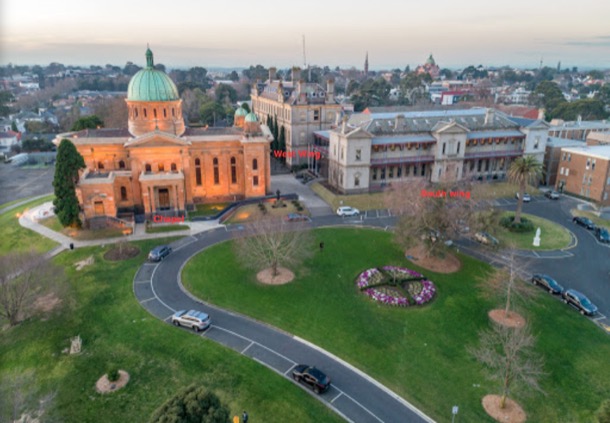
Initially they boarded at the preparatory school, Burke Hall. The buildings of Burke Hall were put together from a trio of mansions on the hill known as Studley Park, some bought by, others bequeathed to, the Jesuits. It first opened, as Xavier College’s junior school in 1921.
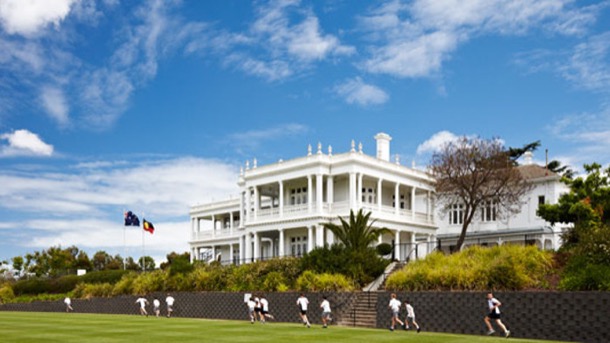
Xavier’s senior School is even older. The South Wing is the original building of Xavier College. The foundations date from 1872, the front dates from the opening of the College in 1878, the back half was completed in 1884. It was listed by the National Trust in 1987.

Xavier’s main chapel would have been being built when our father arrived. It was finally completed in 1934. The chapel is a fine building with a huge dome. I have sung in a concert under that dome, and Sue has been in the audience for another concert there.
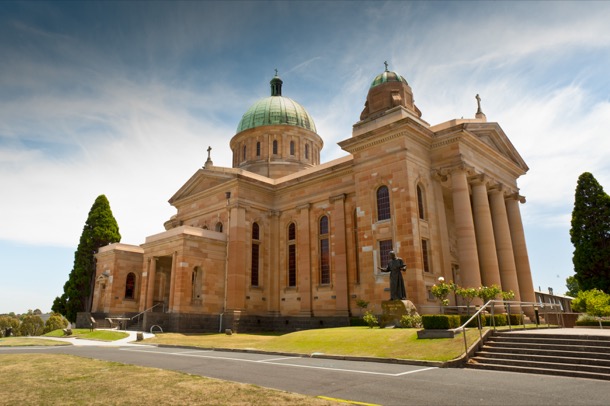
These posts can be viewed as a virtual pilgrimage of the structures and buildings in Melbourne and how they relate to our family. Melbourne is undergoing a tumultuous time of change, as, in 2019, its population grows to nearly five million. Our family landmarks are inevitably caught up in the changes too, as you will see.
Our first post covers the suburb of Hawthorn.

Glenferrie Road
733 Glenferrie Road is listed on the Glenferrie Road Historic walk as the ‘historic mansion Toolangi. It was built in1905 as a doctor's surgery and residence for William Clayton, physician and surgeon.’
This house is significant to our family as two generations of Bourke doctors lived and worked here and our father spent his teenage years here.

It was in the late 1930s that our paternal grandfather Dr. Hugh Bourke and family moved to Glenferrie Road from Koroit. Presumably Grandfather Bourke bought both the property and the medical practice.

At this time, our father was at secondary school at Xavier, where he had boarded until the move. He continued to live in the Glenferrie Road house until he was married in 1945.
After Grandpa Bourke’s death in 1950, Grandma Bourke moved out and Dad’s brother Jack and his family moved into the house. Jack took over the practice, which he ran until he retired.
I have clear memories of the house, both visiting Uncle Jack and, once or twice, the surgery. The house seemed enormous and imposing, and as we mentioned in a previous post, the paraphernalia of Roman Catholicism was very evident. Uncle Jack also had a greenhouse in the back garden where he grew orchids and Christmas Lilies. The garden shed and the greenhouse where still there until recently.
I still associate the perfume of Christmas Lilies with visits to Grandma Bourke at Christmas.
The building next door to Toolangi was the Hawthorn Motor Garage, built in 1912 . From the 1920s the garage was run by Albert James Kane and family, who had it for 20 to 30 years. They introduced the first electric petrol pump in Hawthorn.

The Hawthorn Motor Garage building is on the Victorian Heritage Register. It is the oldest known purpose-built motor garage in Victoria. Dad would have been very familiar with the Kanes and the garage: while courting our mother, he was lucky enough to be able to borrow his father’s car and use his petrol coupons to fill up at the garage next door. As it was wartime, petrol was strictly rationed but doctors received extra coupons, that Dr. Hugh obviously allowed his son to use.
In April 2019, when we visited it, the site of the house and the garage were in the process of being redeveloped. The garden and out buildings have been cleared away but the main structures of the Hawthorn Motor Garage and Toolangi remain. They will be repurposed as part of the new apartment complex being built on this corner.

At the other end of Glenferrie Road shops is the Catholic Church. An imposing bluestone structure, the Church of the Immaculate Conception still dominates this busy corner. The Bourke family would have attended Mass here every Sunday. Now I walk past here every six weeks on my way to have my hair cut. Time marches on.

Urquart Street
After our grandfather Hugh’s death in 1950, Grandma Bourke moved a few streets away to Urquhart Street, still in Hawthorn, leaving Jack to bring up his family and run his practice from the Glenferrie Road house.
We remember this house well. Grandma Bourke was a keen gardener whose beautiful roses and bulbs were fertilised by the manure from our parents’ chooks. A huge weeping deciduous tree in the front yard afforded a play area for visiting grandchildren. The house was big enough for our aunt and family, who lived near Warrnambool, to stay over Christmas.
It had a coal cellar, accessed by a trapdoor on the back verandah, with fed the coke heater.

The house looks much the same in 2019, as it did sixty years ago, when Grandma served cake and tea in beautiful china in the front room to her visitors, and mugs of tea with slabs of bread and butter to workmen on the back verandah.
Xavier College
Our uncle and father, first went as borders to Xavier College for their secondary eduction. When our father began there in 1932, Xavier had already been there for fifty years. It was and still is, the premier Catholic Boys private school in Melbourne.

Initially they boarded at the preparatory school, Burke Hall. The buildings of Burke Hall were put together from a trio of mansions on the hill known as Studley Park, some bought by, others bequeathed to, the Jesuits. It first opened, as Xavier College’s junior school in 1921.

Xavier’s senior School is even older. The South Wing is the original building of Xavier College. The foundations date from 1872, the front dates from the opening of the College in 1878, the back half was completed in 1884. It was listed by the National Trust in 1987.

Xavier’s main chapel would have been being built when our father arrived. It was finally completed in 1934. The chapel is a fine building with a huge dome. I have sung in a concert under that dome, and Sue has been in the audience for another concert there.

I can hear sleigh bells
13 12 17 15:36 Filed in: Children 1950s | Teenagers 1960s
Christmas has always been special time in our lives. It is not surprising, I suppose, as the whole of society gears up for this event. Now in our multicultural society, Christmas is driven by the commercialisation. When we were growing up, it was because everyone in our world was ‘Anglo’ and many people went to church. For us too, it was one of the few variations from routine, and one of the few times in a year when we went visiting.
Christmas also marked the end of the school year and the beginning of holiday preparations. When we were very young, this involved a wonderful week staying with Pauline, Auntie Marge and Uncle George and later, the huge preparations for camping at Shoreham.
In our minds, Christmas preparations are linked with images of Mum sewing at the kitchen table; cotton ends; bits of material with paper patterns securely pinned to them; standing still to have hems pinned up; and the last minute wrapping of presents amongst the sewing detritus. Dad was packing the trailer and driving to Shoreham to set up the tent. Our parents must have been very busy, but we remember it as a very happy time. Margaret and I remember decorating the tree that was of course a pine tree.
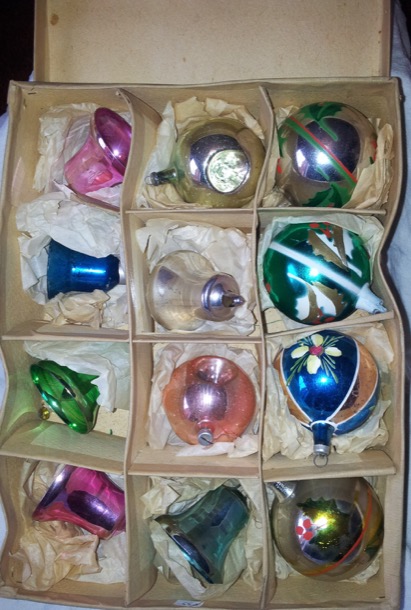
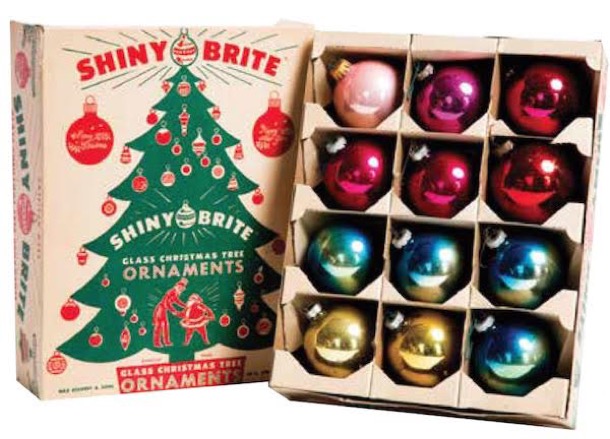
Christmas baubles were made of glass: fragile and expensive.
Choosing the tree was quite a process, as was the decorating, as trees were irregular shapes, not manicured as they are today.
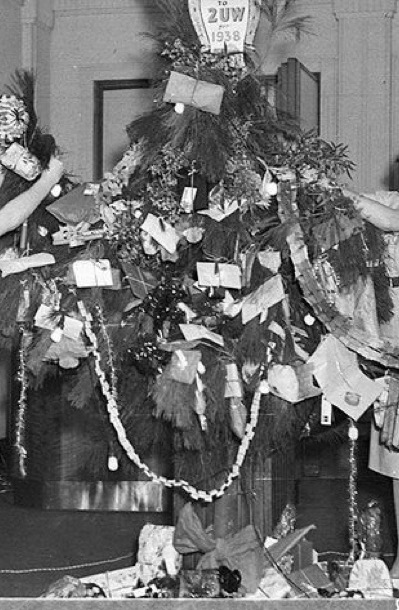
With Mum so busy sewing, it was also easy to slip unnoticed into the dark, tall built-in cupboard in their bedroom, where every year, on the second top shelf, mysterious exciting items in brown paper bags were stored. We remember doing quite a bit of poking and prodding, but never unwrapping and having a real good look. This would have to wait until Christmas morning.
Margaret and I also saved our pocket money for Christmas and bought presents for Aunts, Uncles, Great Aunts and Grandparents. We had wonderful fun in the Coles Emporium in Box Hill choosing the most wonderful pressies.
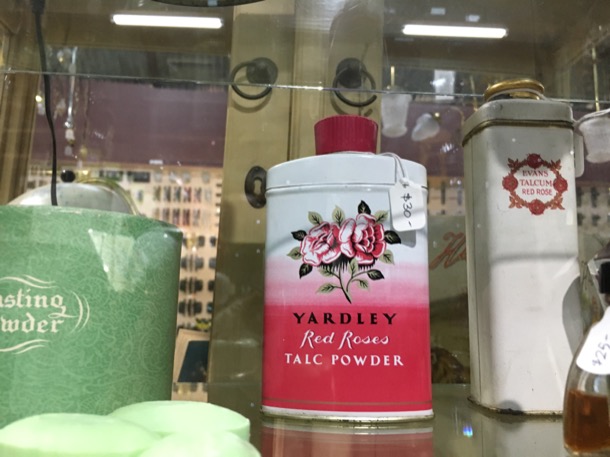
We choose strong smelling bath salts for Auntie Bert, delightful ornaments for Grandma Bourke, talcum powder for Auntie Tish and often disappointingly, hankies for the men, as they were very hard. The shops, even the department stores, were very, very different. A few Christmas decorations were evident, but shops generally were less cluttered, as there was little if any self service.

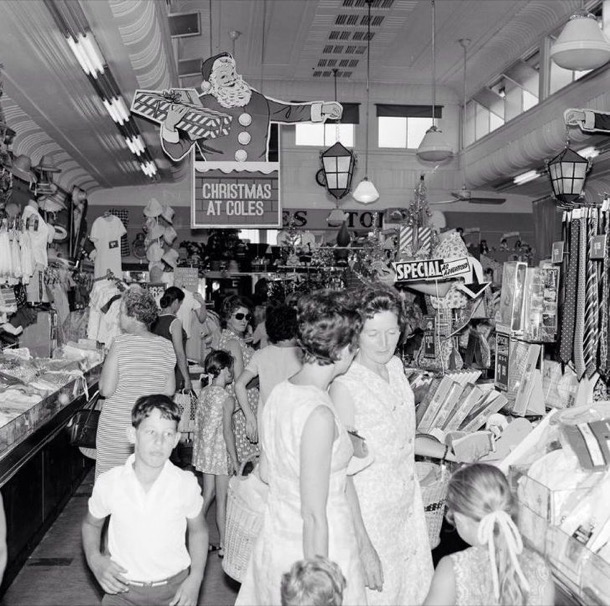
Once purchased and examined we wrapped the presents, made and wrote cards, and either posted or delivered them personally on Christmas Day. Sometimes we also made presents. One year it was calendars. We made them with a prepared calendar printed format and found interesting pictures to paste in for each month. Great fun!
Another delightful memory is of the Salvation Army brass bands who marched the suburban streets before Christmas, stopping every now and again to play three or four carols on a corner. If we were lucky they would stop nearby and we could peer out the window and see them in their uniforms playing the shiny brass instruments. It was always disappointing to hear the tread of feet in unison, as they marched away to the next spot.
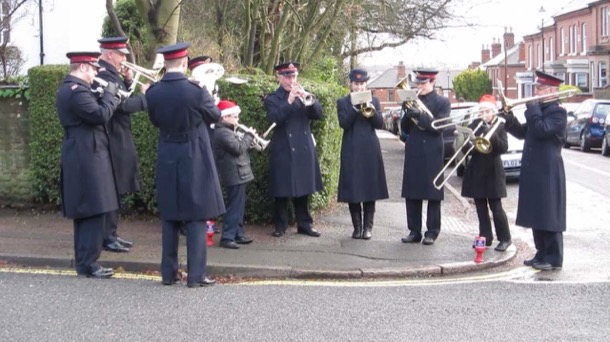
One such very hot night , Christmas Eve actually, the Salvation Army Band had moved on and apparentIy I convinced Margaret that we could hear sleigh bells. Margaret is not sure of it but I am!
I must have been about seven or eight when my suspicions about the identity of Father Christmas were confirmed, although I did still try to deny it and believe for a few years after that. We were staying in a little fibro holiday house in Rosebud with another family. The children were squashed in together in one room, on beds and mattresses on the floor. Late on Christmas Eve, I saw two figures, our parents, laden with crinkly, crunchy pillowcases, stumbling around the crowded room putting the ‘sacks’ on the respective beds. I remember telling Mum that I had seen them, and being cautioned to keep the knowledge to myself. I did!
Christmas Eve for us didn’t involve special preparations or rituals, other than the placing of a pillow slip on the end of each bed. We called these “sacks”. Sue remembers “hearing” Santa’s sleigh bells one year, and sometimes the Salvos street-corner concert would be on this special night, but generally the excitement began on waking.
As soon as I remembered the specialness of this particular morning, I would reach out my toes and touch the lumpy sack that now took up a good ideal of the bottom of the bed. The crinkle of wrapping paper and the solidity of its contents were thrilling. Sue and I shared a room, and the first one awake would wake the other. I guess we woke the two boys too, or perhaps they woke us up.
The ritual was then for each of us to carry our sacks up the hall to our parents’ room and have a mass unwrapping there, on their bed.
When Sue and I talked at length about our reminiscences of our childhood Christmases, one of us raised the question of what presents we remember. The answer is: hardly any. And yet we had very few toys, and only two occasions, Christmas and birthdays, when we got any.
“Stuff” was very expensive and in short supply when we were little. And clearly it was not terribly important in our lives. In our sacks there were one or two intriguing and fairly roughly wrapped parcels. There might be a toy, maybe some “special” clothes, a bag of mixed lollies, chocolate coins, eaten then and there, and little else. One year we were given hard cover bibles, (not very exciting). Later in the day, we presume there were presents from other family members, but we do not remember the actual items, just the excitement of unwrapping and the specialness of the occasion.
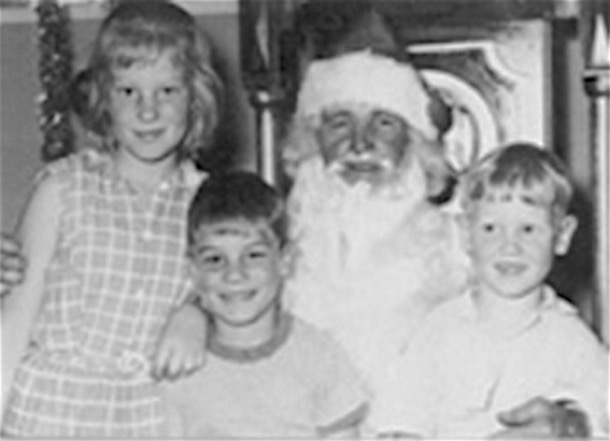
A rare Christmas picture, about 1962. Margaret, Ian and Chris.
One Christmas morning I do clearly remember, was when I woke to find a trail of wool from my sack leading to the large room at the back of the house we called the rumpus room. When I reached the end of it there was a card telling me that my new piano would be placed here. There was a corresponding card on my sack saying that the next year I would start having piano lessons. I had been asking whether I could learn the piano for some time, and, looking back from here, it seems as if I knew that this was going to be very significant in my life.
Other presents we remember which could just as easily have been birthday presents are:
The joint present to all of us of a swing. We got out there early on Christmas morning to use it, and made ourselves sick.
A pogo stick, another joint present.
Roller skates, which attached to our shoes. (Only the boys had bicycles, though we had tricycles when we were really little)
Dolls: mine was black and Sue’s caucasian.
Beach toys, such as bucket and spade, and, later, rubber blow up surf matts.
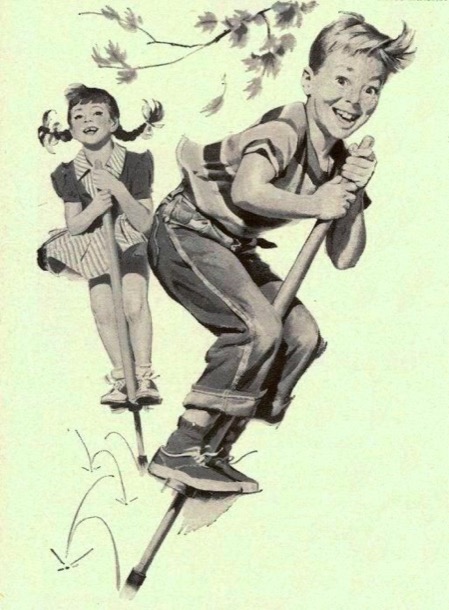
After we had strewn our parents’ bedroom with paper and eaten far too many lollies and chocolates, we had our usual breakfast of cereal, sugar and milk, put on our “best” dresses, socks and either our school shoes, or sandals (we only owned one pair of each) and headed off to church.
Sue remembers the Christmas church service as “a little less boring than usual”. For me, church was all about the music. The Christmas church service was overflowing with once-a-year-Christians and there was an air of excitement among all age groups.
After church there was a small, not very special lunch at home, and our mother doing last minute wrapping of presents for the afternoon. Then, I guess still wearing our best, (although some of us were quite prone to getting extremely dirty extremely quickly), we headed off for the afternoon at Grandma Bourke’s place.
It is about this part of Christmas Day that I have the clearest recollections.
We have written in another post (“Cut out of the Will” 15/6/2016) about our parents’ ”mixed marriage” and the disapproval with which their union was viewed.
Our mother called her mother in law “Mrs Bourke”, which was also her own name of course. We were aware of the tensions between them, and acutely aware of the warmth and familiarity between “Grandma Bourke” and her other grandchildren, who lived in the country and stayed with her every Christmas. They called her “Gannar”.
Presents were exchanged, as we sat in a circle. Interestingly, while we can remember giving presents to the grown ups, Grandma, Auntie Tish and Uncle Matt, we don’t remember any specifics of the presents we were given.
Mostly, for us, these visits were about the food. Afternoon tea, in the front room, stuffed full of dark furniture, was a grand affair. There was a huge silver teapot with its cosy, on a double decker tea trolley with cups and saucers. There was cake, slices and delicious savouries in huge quantities.

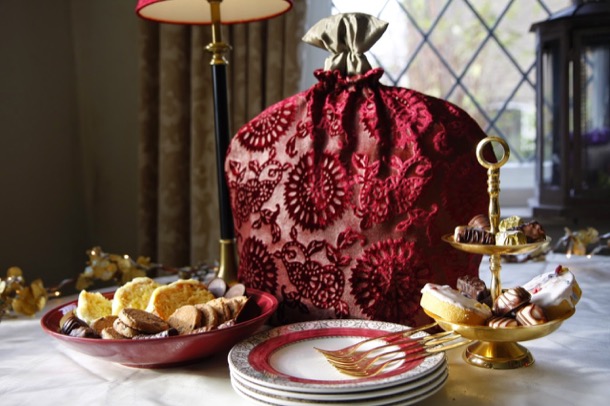
The grownups made conversation, about things that were not of our world: the races, farming the cattle property that Uncle Matt owned in the Western District, television, (Grandma Bourke was a huge fan of Graham Kennedy) and people we didn’t know.
Afterwards we children went outside under the weeping elm tree in the front yard, to play. It is only there I have any memory of interacting with our cousins, and not much there either. They were younger than us, and lived in a very different world. Occasionally our other cousins, Uncle Jack’s children, even less familiar, would come to visit on Christmas Day.
Some years, this was the end of Christmas for us. We went home for a light dinner and woke up to the rest of the holidays, which, in later years, meant six weeks camping at Shoreham.
Sometimes, though, we went on from Grandma Bourke’s in Hawthorn, to Beaumaris and our mother’s sister’s place. After the stiff, tense formality of Grandma Bourke’s, Auntie Marge’s warm welcome and the relaxation of playing with our familiar cousin Pauline, was a huge relief. We would have a wonderful meal and exchange presents lounging around the floor in the spacious living room. There was even a glass of wine (Penfolds Moselle in a flagon) with dinner for some of the adults. Alcoholic drinks did not feature in our parents’ lives.
We did not see our maternal grandparents on Christmas Day. We have no memory of them sharing anything Christmassy with us, even when they were living with us.
Most families have developed Christmas traditions. We remember Christmas as being confined to the day itself and the night before, and we suspect this might have been a common thing in those days. Our family did not entertain. There were never any parties, even family parties. When we look back on this time, and compare it to what kids these days experience as Christmas, it was pretty sparse. Sue and I, reflecting on our childhood Christmases, are aware of, and a bit surprised at, how warmly we remember them.
Christmas also marked the end of the school year and the beginning of holiday preparations. When we were very young, this involved a wonderful week staying with Pauline, Auntie Marge and Uncle George and later, the huge preparations for camping at Shoreham.
In our minds, Christmas preparations are linked with images of Mum sewing at the kitchen table; cotton ends; bits of material with paper patterns securely pinned to them; standing still to have hems pinned up; and the last minute wrapping of presents amongst the sewing detritus. Dad was packing the trailer and driving to Shoreham to set up the tent. Our parents must have been very busy, but we remember it as a very happy time. Margaret and I remember decorating the tree that was of course a pine tree.


Christmas baubles were made of glass: fragile and expensive.
Choosing the tree was quite a process, as was the decorating, as trees were irregular shapes, not manicured as they are today.

With Mum so busy sewing, it was also easy to slip unnoticed into the dark, tall built-in cupboard in their bedroom, where every year, on the second top shelf, mysterious exciting items in brown paper bags were stored. We remember doing quite a bit of poking and prodding, but never unwrapping and having a real good look. This would have to wait until Christmas morning.
Margaret and I also saved our pocket money for Christmas and bought presents for Aunts, Uncles, Great Aunts and Grandparents. We had wonderful fun in the Coles Emporium in Box Hill choosing the most wonderful pressies.

We choose strong smelling bath salts for Auntie Bert, delightful ornaments for Grandma Bourke, talcum powder for Auntie Tish and often disappointingly, hankies for the men, as they were very hard. The shops, even the department stores, were very, very different. A few Christmas decorations were evident, but shops generally were less cluttered, as there was little if any self service.


Once purchased and examined we wrapped the presents, made and wrote cards, and either posted or delivered them personally on Christmas Day. Sometimes we also made presents. One year it was calendars. We made them with a prepared calendar printed format and found interesting pictures to paste in for each month. Great fun!
Another delightful memory is of the Salvation Army brass bands who marched the suburban streets before Christmas, stopping every now and again to play three or four carols on a corner. If we were lucky they would stop nearby and we could peer out the window and see them in their uniforms playing the shiny brass instruments. It was always disappointing to hear the tread of feet in unison, as they marched away to the next spot.

One such very hot night , Christmas Eve actually, the Salvation Army Band had moved on and apparentIy I convinced Margaret that we could hear sleigh bells. Margaret is not sure of it but I am!
I must have been about seven or eight when my suspicions about the identity of Father Christmas were confirmed, although I did still try to deny it and believe for a few years after that. We were staying in a little fibro holiday house in Rosebud with another family. The children were squashed in together in one room, on beds and mattresses on the floor. Late on Christmas Eve, I saw two figures, our parents, laden with crinkly, crunchy pillowcases, stumbling around the crowded room putting the ‘sacks’ on the respective beds. I remember telling Mum that I had seen them, and being cautioned to keep the knowledge to myself. I did!
Christmas Eve for us didn’t involve special preparations or rituals, other than the placing of a pillow slip on the end of each bed. We called these “sacks”. Sue remembers “hearing” Santa’s sleigh bells one year, and sometimes the Salvos street-corner concert would be on this special night, but generally the excitement began on waking.
As soon as I remembered the specialness of this particular morning, I would reach out my toes and touch the lumpy sack that now took up a good ideal of the bottom of the bed. The crinkle of wrapping paper and the solidity of its contents were thrilling. Sue and I shared a room, and the first one awake would wake the other. I guess we woke the two boys too, or perhaps they woke us up.
The ritual was then for each of us to carry our sacks up the hall to our parents’ room and have a mass unwrapping there, on their bed.
When Sue and I talked at length about our reminiscences of our childhood Christmases, one of us raised the question of what presents we remember. The answer is: hardly any. And yet we had very few toys, and only two occasions, Christmas and birthdays, when we got any.
“Stuff” was very expensive and in short supply when we were little. And clearly it was not terribly important in our lives. In our sacks there were one or two intriguing and fairly roughly wrapped parcels. There might be a toy, maybe some “special” clothes, a bag of mixed lollies, chocolate coins, eaten then and there, and little else. One year we were given hard cover bibles, (not very exciting). Later in the day, we presume there were presents from other family members, but we do not remember the actual items, just the excitement of unwrapping and the specialness of the occasion.

A rare Christmas picture, about 1962. Margaret, Ian and Chris.
One Christmas morning I do clearly remember, was when I woke to find a trail of wool from my sack leading to the large room at the back of the house we called the rumpus room. When I reached the end of it there was a card telling me that my new piano would be placed here. There was a corresponding card on my sack saying that the next year I would start having piano lessons. I had been asking whether I could learn the piano for some time, and, looking back from here, it seems as if I knew that this was going to be very significant in my life.
Other presents we remember which could just as easily have been birthday presents are:
The joint present to all of us of a swing. We got out there early on Christmas morning to use it, and made ourselves sick.
A pogo stick, another joint present.
Roller skates, which attached to our shoes. (Only the boys had bicycles, though we had tricycles when we were really little)
Dolls: mine was black and Sue’s caucasian.
Beach toys, such as bucket and spade, and, later, rubber blow up surf matts.

After we had strewn our parents’ bedroom with paper and eaten far too many lollies and chocolates, we had our usual breakfast of cereal, sugar and milk, put on our “best” dresses, socks and either our school shoes, or sandals (we only owned one pair of each) and headed off to church.
Sue remembers the Christmas church service as “a little less boring than usual”. For me, church was all about the music. The Christmas church service was overflowing with once-a-year-Christians and there was an air of excitement among all age groups.
After church there was a small, not very special lunch at home, and our mother doing last minute wrapping of presents for the afternoon. Then, I guess still wearing our best, (although some of us were quite prone to getting extremely dirty extremely quickly), we headed off for the afternoon at Grandma Bourke’s place.
It is about this part of Christmas Day that I have the clearest recollections.
We have written in another post (“Cut out of the Will” 15/6/2016) about our parents’ ”mixed marriage” and the disapproval with which their union was viewed.
Our mother called her mother in law “Mrs Bourke”, which was also her own name of course. We were aware of the tensions between them, and acutely aware of the warmth and familiarity between “Grandma Bourke” and her other grandchildren, who lived in the country and stayed with her every Christmas. They called her “Gannar”.
Presents were exchanged, as we sat in a circle. Interestingly, while we can remember giving presents to the grown ups, Grandma, Auntie Tish and Uncle Matt, we don’t remember any specifics of the presents we were given.
Mostly, for us, these visits were about the food. Afternoon tea, in the front room, stuffed full of dark furniture, was a grand affair. There was a huge silver teapot with its cosy, on a double decker tea trolley with cups and saucers. There was cake, slices and delicious savouries in huge quantities.


The grownups made conversation, about things that were not of our world: the races, farming the cattle property that Uncle Matt owned in the Western District, television, (Grandma Bourke was a huge fan of Graham Kennedy) and people we didn’t know.
Afterwards we children went outside under the weeping elm tree in the front yard, to play. It is only there I have any memory of interacting with our cousins, and not much there either. They were younger than us, and lived in a very different world. Occasionally our other cousins, Uncle Jack’s children, even less familiar, would come to visit on Christmas Day.
Some years, this was the end of Christmas for us. We went home for a light dinner and woke up to the rest of the holidays, which, in later years, meant six weeks camping at Shoreham.
Sometimes, though, we went on from Grandma Bourke’s in Hawthorn, to Beaumaris and our mother’s sister’s place. After the stiff, tense formality of Grandma Bourke’s, Auntie Marge’s warm welcome and the relaxation of playing with our familiar cousin Pauline, was a huge relief. We would have a wonderful meal and exchange presents lounging around the floor in the spacious living room. There was even a glass of wine (Penfolds Moselle in a flagon) with dinner for some of the adults. Alcoholic drinks did not feature in our parents’ lives.
We did not see our maternal grandparents on Christmas Day. We have no memory of them sharing anything Christmassy with us, even when they were living with us.
Most families have developed Christmas traditions. We remember Christmas as being confined to the day itself and the night before, and we suspect this might have been a common thing in those days. Our family did not entertain. There were never any parties, even family parties. When we look back on this time, and compare it to what kids these days experience as Christmas, it was pretty sparse. Sue and I, reflecting on our childhood Christmases, are aware of, and a bit surprised at, how warmly we remember them.
"Cut out of the Will"
15 06 16 16:52 Filed in: Jim
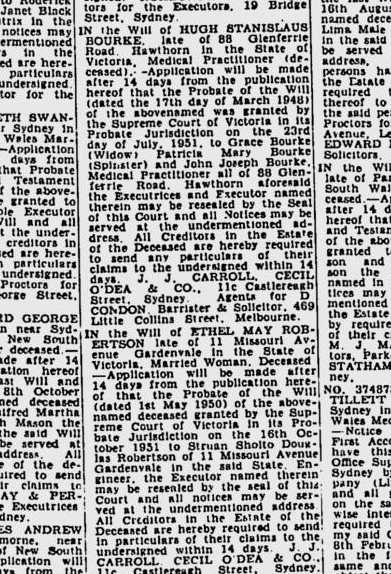
Growing up we had heard many times how our father had been ‘cut out of the will’ by his father because he had married a Protestant and renounced the Catholic faith.
As we were researching the early life of our Catholic grandmother Grace, we stumbled across the application for probate for the will of Doctor Hugh Stanislaus Bourke, our grandfather. His widow Grace, his son Jack, his daughter Patricia are mentioned but no mention of James Vincent Bourke his second son, our father.
Here, published in the Argus Newspaper, was the brutal reality of what this divide really meant in our parent’s lives. It was no small sum: 36,353 pounds. In todays world this would be equivalent to leaving an estate valued at six and a half million dollars.
More shocking is the date, on which the will was written March 17, 1948: not when they married, but three years later, when Alice was only just pregnant with their first child who was not going to be raised as a Catholic. Was this the catalyst?
Australia and the Irish Catholic/English Protestant divide.
In the very earliest days of the NSW penal colony, many of the convicts and early settlers were Irish catholics, and most of the British Military, who ran the prison colony were Anglican protestants.
The first few decades of the colony coincided with unrest and rebellion in Ireland, which was still under English rule. The authorities were nervous of the very large numbers of Irish convicts and settlers, who spoke their own language and had a different religion.
Most of Ireland became a republic and a separate country in 1922. Although there was still unrest in Northern Ireland, which remains part of England to this day, most of the official heat went out of the Irish English divide, though it remained in people’s consciousness.
Australia had an influx of European migrants in the nineteen-forties and fifties, and gradually the clear division of Australian into Catholics and Protestants became blurred, though there was still institutionalised prejudice against Catholics, right up until the 1980s.
The other: the mysterious Catholic world seen through our eyes.
Dark, heavy wooden framed paintings of the Virgin Mary and the Crucified Christ were the mysterious evidence of the Catholicism of our grandmother. We only visited Grandma Bourke’s house three or four times a year for very formal, if delicious, afternoon tea. Our relationship with her too was very formal, a peck on the cheek hello and goodbye and no spontaneous hugs and signs of affection, as we saw our cousins receive.
We knew nothing of this strange Catholic world as we were Protestant and our parents were both heavily involved at St James Presbyterian Church, Wattle Park, where there were a few bare crosses, but no other iconography.
The dark religious ‘icons’ we saw in Grandma’s house were also to be found in Uncle Jack’s house in Glenferrie Road. Most mysterious was the large porcelain statue of Mary. Mother of God, clad in a pale blue robe and further upstairs another large porcelain statue of the Crucified and Risen Christ complete with bleeding nail holes. Gruesome stuff!
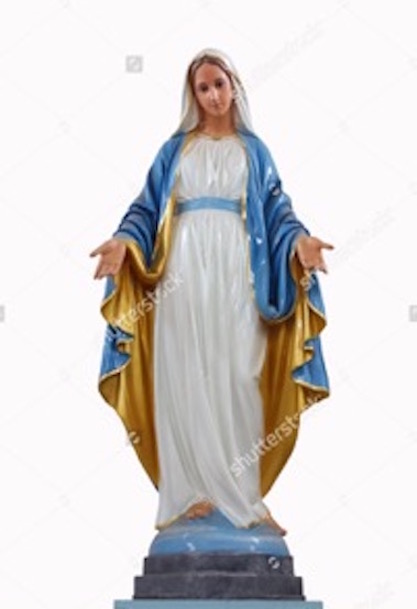
When we were growing up, even though we had Catholic relatives, we would never have gone into the Catholic Church. On several occasions we saw, at the local Catholic Church, little girls dressed up as Brides of Christ, lined up and waiting to process into the church for their First Communion.
Nuns in full habit were also very much part of our early memories. I remember back shiny lace up shoes visible under the long heavy black robes, the white starched wimple and veil and, above all, the clanking sound of the Rosary Beads and keys on a chain around their waists.
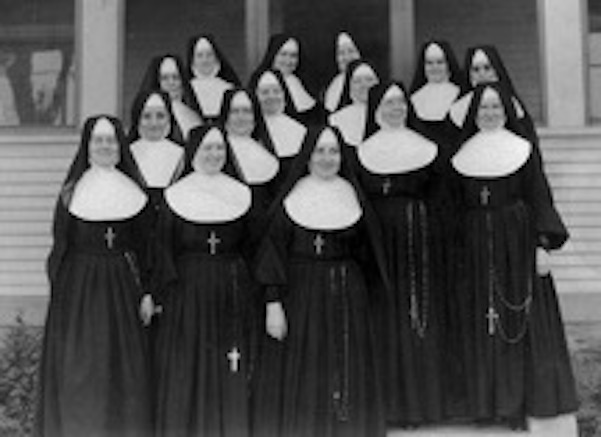
Even though, by the nineteen forties, there were Catholics in all walks of life, ordinary people still defined themselves and each other by whether they were Catholic or Protestant.
They went to separate schools, even at primary school level. If you went to a Protestant private school, you bought your uniform at Myers. Foys, another department store, catered for the Catholic ones.
Catholics were forbidden to set foot in a Protestant church. One story from this time is of the brothers of a Catholic woman marrying a Protestant forced to stand outside and watch the ceremony through the window. When Protestants and Catholics married it was called a “mixed marriage”
There was lots of name calling… “Micks”, “papists”, “proddy dogs”. Our father, attending the Catholic School in his home town of Koroit during the nineteen thirties, told us the story of him running home, chased by kids from the state school, turning and calling “proddy dogs, jump like frogs” or perhaps it was the others calling him a “Catholic dog” … probably both.
So when our father, Jim, told his Irish Catholic parents about his new girlfriend, there were probably alarm bells right from the beginning. Jim and Alice met at work, the Maribyrnong Munitions Factory.
They married in 1945, a couple of months before the end of the war. She did not dress as a bride, because it was still war time, and they had a quiet ceremony in the Congregational Church in Surrey Hills, near Alice’s home and a reception at Wattle Park Chalet.
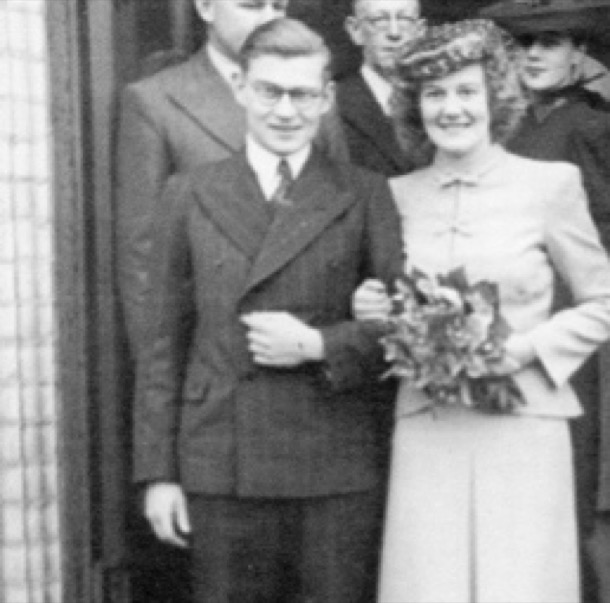
The couple lived with her parents, Alfred and Alfreda, until they built and moved into their own house in the early nineteen fifties. Alice’s parents seem to have been very tolerant. Their eldest daughter had married a Hungarian Jew a few months earlier and now their other daughter, a Catholic. Theirs was a working class family, educated and valuing education, but without much money or position in society.
Jim’s parents were from a different class as well as a different religion. Grace, as we have discovered had been a society girl and Hugh, a well respected country doctor. They did not come to the wedding. We can only imagine the conversations, the arguments, the pleading. To them, Jim’s parents, their precious son was denying himself an afterlife in Heaven, and bringing shame on the family. Any children born to this marriage would be viewed as illegitimate. In the eyes of the Catholic Church our parents were not married.
One “family story” tells of Jim’s sister, Tish, writing a letter pleading for them to “marry properly”. As children we knew that our father had “left the Catholic Church” in order to marry our mother and that he had been “cut out of the will”. It is part of our family mythology. We were aware of our mother’s bitterness at our family’s financial struggles. We witnessed the stiff courtesy with which she greeted her mother-in-law, who she always addressed as Mrs Bourke.
Now, looking at the stark reality of this newspaper article, we feel a little of her outrage. We understand better the enormity of that decision, the extraordinary timing of Hugh’s change of will, the sense of being the ‘black sheep” family that hung over us when we visited out Grandmother.
Grace McCormack, our other grandmother.
25 05 16 17:04 Filed in: Jim
Until last week we knew very little about our paternal Grandmother, Grace. We both had the feeling from our father that she had been a “somebody”. I remember him referring to her as “Gracie McCormack”, as if that meant something special. We knew that, as the doctor’s wife in Koroit, she had been an important person. Then we did a little research:
Grace McCormack was born in 1893 at the family home, called Balham Hill in Molesworth, near Yea. This is only nineteen kilometres from Sue and Jono's new property Billy Goat Hill.
Grace's father, John and mother Johanna, were highly respected and wealthy members of the community, who had bought the huge grazing property, nearly 15,000 acres, in 1886.
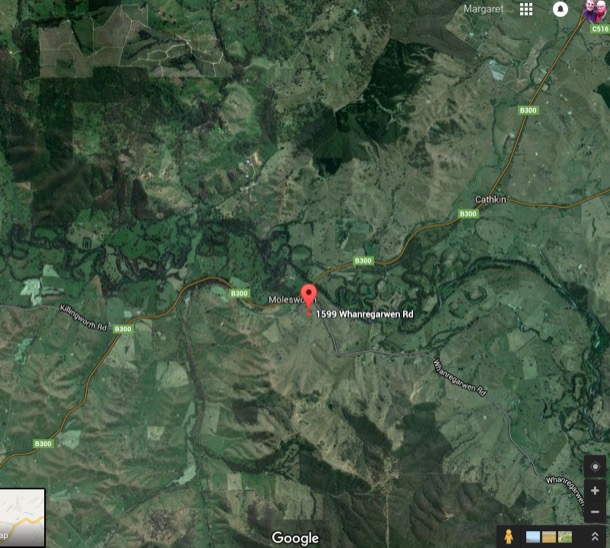
The house, still there today, had been built by one of the first white settlers in the area, Edward Cotton. It was near the Goulburn River, built of bricks made on the property.
The address is 1599 Whanregarwen Road MOLESWORTH
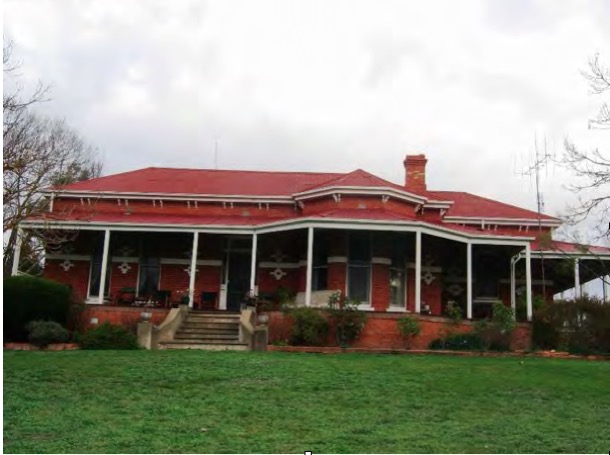
When he first arrived in the district he (Edward Cotton, who later published a book about Australian birds) wrote of the view over the valley from the Balham Hill homestead in his correspondence." I was much pleased with the beauty of the spot. The trees are rather thinly scattered over the flat, and there are extensive lagoons”. ”White cockatoos, king parrots, parakeets, eagle hawks, several species of honey-suckers and numerous tribes of smaller birds, including the bellbird, the superb warbler, etc., were plentifully scattered about this station. Ducks, black swans, divers, kingfishers, herons were constantly seen on or about the lagoons”.
HISTORY OF BALHAM HILL (from the Shire of Murrindindi Heritage Report)
The original homestead was built for Edward Cotton in 1842 or '43 using bricks made on the property. A report on the request for a pre-emptive right of June 1854 refers to a brick home, woolshed, outhouses and stables. Edward Cotton, the first squatter of Balham Hill, was born in 1803 Balham Hill, Clapham Common near London. Despite his ambitions, he failed as a pastoralist and sold Balham Hill in 1848. He died from drowning at Moorabbin in 1860, one a week after being suspended from his position as Registrar (Chief Clerk) of the County Court for 'extravagance and financial mismanagement'. In 1886 the property was sold by William Merry to John McCormack. He and his wife Johanna had five children, one of whom, Aloysius, died as an infant. The remaining children, Jane, Grace, Leo and Cyril grew up at Molesworth and attended Molesworth State School. In the early 1900s John McCormack rebuilt the homestead, retaining and incorporating into the new building some of Cotton's original homestead. The front rooms and hall were built for McCormack. The E-W passage is believed to be the front verandah of the original building, and there may have been many more rooms at the rear. During the McCormacks' time there was a circular drive at the front which was lost when road works altered the entrance. In 1930, following the death of John McCormack, the property was divided. Leo retained Balham Hill and married Zillah Maling. In 1942 Leo sold Balham Hill and moved to Melbourne. Cyril, who married Josephine Conlan in June 1930, took over a large area near Cottons Pinch and a home was built on this section. The property was named Alencon after a village in northern France. An early large orchard on the east side of the house, which includes the establishment of a Mulberry tree, was still in existence in 1994. An early rose garden once occupied the west side.
It is believed that the house originally had 17 rooms, but some of them were removed in the mid-20th century.
Births, deaths and weddings have all taken place at Balham Hill. Notably, Clara Ridd was born there during the 1870 flood. It is thought Balham Hill provided accommodation to travellers en route to the north east.
Grace was the second child. She had an older sister, Jane and three younger brothers, one of whom, Aloysius, died aged only ten months. He is buried in the Yea Cemetery. The other two boys were called Leo and Cyril. The four children all attended Molesworth State School.
John was a Justice of the Peace, a community leader, who could sign official documents and witness things for people. He donated the land for the Molesworth Community Hall.
John and Johanna had the house remodelled in the early 1900s. It had 17 rooms and a circular driveway.
The children were sent away to boarding school for their secondary education. The boys probably went to Xavier College, the girls to the Convent of Mercy in Fitzroy:
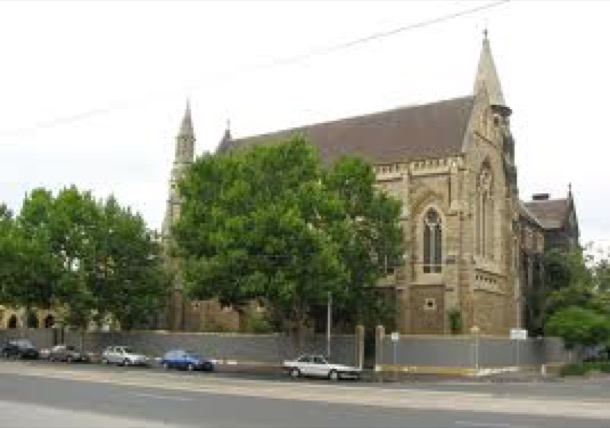
Jane was married almost exactly one month before the First World War began, in 1914: a grand affair at St Patrick’s Cathedral. Grace was her bridesmaid. The newspaper coverage of this social event is worth a read:
MR. T. M. B. COFFEY TO MISS J. McCORMACK.
The marriage of Mr. T. M. B. Coffey, third son of the late John Coffey and Mrs. Coffey, of “Kewell," Riversdale Road, Hawthorn, and Miss Jean McCormack, elder daughter of Mr. John McCormack, of "Balham Hill” Molesworth was celebrated at St. Patrick's Cathedral, Melbourne, on 27thMay.
The Rev. Father O'Reilly (Castlemaine) officiated. He
was assisted by the Rev. Father Ellis. The altar was beautifully decorated with white flowers. Miss Anderson was at the organ, and played Lohengrin's Wedding March and other beautiful music. The bride, who was given away by her father, wore a gown of soft Oriental satin, gracefully draped in straight
lines, and veiled with a short tunic of fine silk shadow lace. The beautiful court train was lined with shell pink, and finished with true lovers' knots and orange blossom. The Angel sleeves were caught and weighted with pearl tassels. The crossed bodice was of pearl embroidery, veiled with silk shadow lace. A veil of beautiful old Limerick lace (lent by the nuns) was worn, and a shower bouquet of white azaleas and fern was carried. The bridesmaid (Miss Grace McCormack) was frocked in dainty ivory crepe-de chine, the tunic of soft ninon, edged with marabout. The bodice, of soft shadow lace, was veiled with ninon, and finished with a sash of rose-pink velvet. The black velvet hat was wreathed with small winter berries and forget-me-nots. A bouquet of La France roses was carried. The train-bearers were Miss Kathleen McCormack (bride's god-child and cousin) and Miss Margaret Armond (bridegroom's god-child and cousin). They wore dainty little early Victorian dresses of white crepe-de^chine, with empire sashes, of ninon, the neck and sleeves prettily finished with white marabout. Their ninon capes were set with trails of pale pink, and they carried 1830 bouquets of small
pink roses and silver bags (gifts of bridegroom). The bridegroom's gift to the bride was a pianola piano; to bridesmaids, Nellie Stewart bangle; bride to bridegroom, beautifully fitted dressing case. Mr. Leo. McCormack (brother of bride) was best man. The bride's mother was gowned in black cashmere de soie, the skirt gracefully draped with beautiful Chantilly lace; the bodice of fine black lace, embroidered in gold, and finished with soft white tulle. A black velvet hat, set with ostrich plumes, was worn, and a bouquet of violets was carried. The bridegroom's mother and sister were unable to be present,
being at present on a visit to Dr. Coffey, in Dublin. A reception was held at, the Grand Hotel, followed by a wedding' luncheon to about seventy guests.
Later the bride and bridegroom left for Sydney, en route to New Zealand. The bride travelled in blue coat and skirt, rolled back with collar of white cloth. A black velvet hat, set with a white plume was also worn. The presents were numerous and costly, and included several substantial cheques.
So Grace was given present of a plain gold "Nellie Stewart bangle" These had become a popular fashion accessory for young Australian women in the late 19th and early 20th centuries. Usually worn on the upper arm, they were an emulation of Nellie Stewart's style. (a singing celebrity of the time)
Four years later, at the end of a gruelling four years of war, Grace herself married Hugh Stanislaus Bourke. She was twenty-five. One can’t help but speculate about those four years. How many friends did she lose? Perhaps even an earlier sweetheart.
We know her two brothers survived, because the land was divided between them when their father died in 1930.
Their wedding was a less grand affair, though still held at St Pat’s Cathedral. (Note the excitement of the aeroplane.)
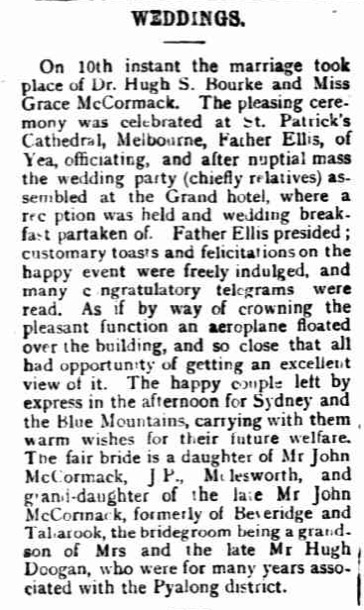
On 10th instant the marriage took place of Dr. Hugh S. Bourke and Miss Grace McCormack. The pleasing ceremony was celebrated at St. Patrick’s Cathedral, Melbourne, Father Ellis, of Yea, officiating, and after nuptial mass the wedding party (chiefly relatives) assembled at the Grand hotel, where a reception was held and wedding breakfast partaken of.
Father Ellis presided; customary toasts and felicitations on the happy event were freely indulged, and many congratulatory telegrams were read.
As if by way of crowning the pleasant function an aeroplane floated over the building, and so close that all had opportunity of getting an excellent view of it. The happy couple left by express in the afternoon for Sydney and the Blue Mountains, carrying with them warm wishes for their future welfare. The fair bride is a daughter of Mr John McCormack, J.P., Molesworth, and granddaughter of the late Mr John McCormack, formerly of Beveridge and Tallarook, the bridegroom being a grand son of Mrs and the late Mr Hugh Doogan, who were for many years associated with the Pyalong district.
Hugh had been registered as a doctor in 1907, and was, by 1918, practising in the western Victorian town of Koroit, where Grace and Hugh raised their three children.
They moved to 88 Glenferrie Road Hawthorn, home and GP surgery, during the 1930s, and stayed there until Hugh’s death in 1951, when the practice was taken over by their eldest son John.
Grace, then aged 58, moved nearby and then to Urquhart Street, Hawthorn, where we can remember visiting her, when we were children.
And a little bit about Grace's paternal grandparents:
Grace comes from quite a line of early Victorian settlers. Grace’s grandfather, also called John McCormack, had large land holdings nearby in Beveridge and Tallarook. Grace was named after her grandmother Grace Bridget, who was reported to be a generous women who was very interested in the social scene. First they lived at ‘Red Barn Farm’ in Beverage, a dairy farm with cheese making facilities including steam driven machinery. They moved to ‘Landscape’ at Tallarook in 1867. It was a much larger gazing property, also with Goulburn River frontage. Grace’s grandmother died at ‘Landscape' having spent 69 of her 83 years in the district.
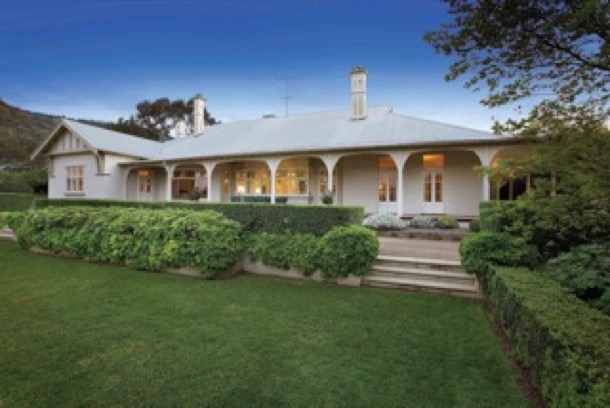
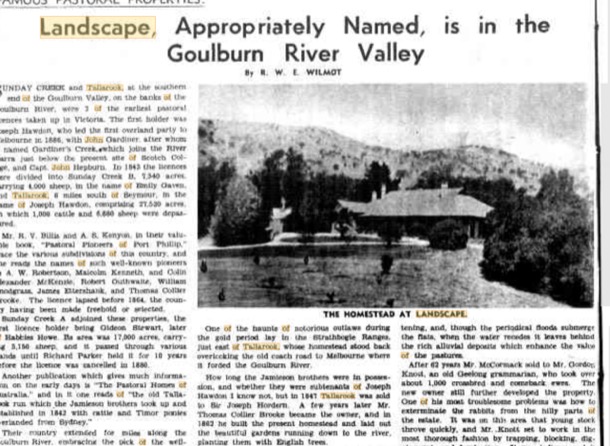
A section of this article reads:
When Tallkarook was still further subdivided in 1867, the homestead block of 3000 acres was purchased by Mr J McCormack, who named his property “Landscape”. It was only natural that in sixty years, a district so favoured by Nature within fifty-five miles of Melbourne, on the main highway from Melbourne to Sydney, should progress, and in that development Landscape shared.
The Goulburn River, with its rich alluvial flats, flanked by slopes between the frontages and the granite hills, make up an ideal property for fattening, and, though the periodical floods submerge the flats, when the water recedes it leaves behind the rich alluvial deposits which enhance the values of the pastures.
And, as an amazing postscript, Jono remembers that his mother, Janie, was school friends with a girl called Janet Essington-Lewis. Her father was the head of BHP and owned Landscape in the 1930s. Janie used to go riding at Landscape with Janet.
Grace McCormack was born in 1893 at the family home, called Balham Hill in Molesworth, near Yea. This is only nineteen kilometres from Sue and Jono's new property Billy Goat Hill.
Grace's father, John and mother Johanna, were highly respected and wealthy members of the community, who had bought the huge grazing property, nearly 15,000 acres, in 1886.

The house, still there today, had been built by one of the first white settlers in the area, Edward Cotton. It was near the Goulburn River, built of bricks made on the property.
The address is 1599 Whanregarwen Road MOLESWORTH

When he first arrived in the district he (Edward Cotton, who later published a book about Australian birds) wrote of the view over the valley from the Balham Hill homestead in his correspondence." I was much pleased with the beauty of the spot. The trees are rather thinly scattered over the flat, and there are extensive lagoons”. ”White cockatoos, king parrots, parakeets, eagle hawks, several species of honey-suckers and numerous tribes of smaller birds, including the bellbird, the superb warbler, etc., were plentifully scattered about this station. Ducks, black swans, divers, kingfishers, herons were constantly seen on or about the lagoons”.
HISTORY OF BALHAM HILL (from the Shire of Murrindindi Heritage Report)
The original homestead was built for Edward Cotton in 1842 or '43 using bricks made on the property. A report on the request for a pre-emptive right of June 1854 refers to a brick home, woolshed, outhouses and stables. Edward Cotton, the first squatter of Balham Hill, was born in 1803 Balham Hill, Clapham Common near London. Despite his ambitions, he failed as a pastoralist and sold Balham Hill in 1848. He died from drowning at Moorabbin in 1860, one a week after being suspended from his position as Registrar (Chief Clerk) of the County Court for 'extravagance and financial mismanagement'. In 1886 the property was sold by William Merry to John McCormack. He and his wife Johanna had five children, one of whom, Aloysius, died as an infant. The remaining children, Jane, Grace, Leo and Cyril grew up at Molesworth and attended Molesworth State School. In the early 1900s John McCormack rebuilt the homestead, retaining and incorporating into the new building some of Cotton's original homestead. The front rooms and hall were built for McCormack. The E-W passage is believed to be the front verandah of the original building, and there may have been many more rooms at the rear. During the McCormacks' time there was a circular drive at the front which was lost when road works altered the entrance. In 1930, following the death of John McCormack, the property was divided. Leo retained Balham Hill and married Zillah Maling. In 1942 Leo sold Balham Hill and moved to Melbourne. Cyril, who married Josephine Conlan in June 1930, took over a large area near Cottons Pinch and a home was built on this section. The property was named Alencon after a village in northern France. An early large orchard on the east side of the house, which includes the establishment of a Mulberry tree, was still in existence in 1994. An early rose garden once occupied the west side.
It is believed that the house originally had 17 rooms, but some of them were removed in the mid-20th century.
Births, deaths and weddings have all taken place at Balham Hill. Notably, Clara Ridd was born there during the 1870 flood. It is thought Balham Hill provided accommodation to travellers en route to the north east.
Grace was the second child. She had an older sister, Jane and three younger brothers, one of whom, Aloysius, died aged only ten months. He is buried in the Yea Cemetery. The other two boys were called Leo and Cyril. The four children all attended Molesworth State School.
John was a Justice of the Peace, a community leader, who could sign official documents and witness things for people. He donated the land for the Molesworth Community Hall.
John and Johanna had the house remodelled in the early 1900s. It had 17 rooms and a circular driveway.
The children were sent away to boarding school for their secondary education. The boys probably went to Xavier College, the girls to the Convent of Mercy in Fitzroy:

Jane was married almost exactly one month before the First World War began, in 1914: a grand affair at St Patrick’s Cathedral. Grace was her bridesmaid. The newspaper coverage of this social event is worth a read:
MR. T. M. B. COFFEY TO MISS J. McCORMACK.
The marriage of Mr. T. M. B. Coffey, third son of the late John Coffey and Mrs. Coffey, of “Kewell," Riversdale Road, Hawthorn, and Miss Jean McCormack, elder daughter of Mr. John McCormack, of "Balham Hill” Molesworth was celebrated at St. Patrick's Cathedral, Melbourne, on 27thMay.
The Rev. Father O'Reilly (Castlemaine) officiated. He
was assisted by the Rev. Father Ellis. The altar was beautifully decorated with white flowers. Miss Anderson was at the organ, and played Lohengrin's Wedding March and other beautiful music. The bride, who was given away by her father, wore a gown of soft Oriental satin, gracefully draped in straight
lines, and veiled with a short tunic of fine silk shadow lace. The beautiful court train was lined with shell pink, and finished with true lovers' knots and orange blossom. The Angel sleeves were caught and weighted with pearl tassels. The crossed bodice was of pearl embroidery, veiled with silk shadow lace. A veil of beautiful old Limerick lace (lent by the nuns) was worn, and a shower bouquet of white azaleas and fern was carried. The bridesmaid (Miss Grace McCormack) was frocked in dainty ivory crepe-de chine, the tunic of soft ninon, edged with marabout. The bodice, of soft shadow lace, was veiled with ninon, and finished with a sash of rose-pink velvet. The black velvet hat was wreathed with small winter berries and forget-me-nots. A bouquet of La France roses was carried. The train-bearers were Miss Kathleen McCormack (bride's god-child and cousin) and Miss Margaret Armond (bridegroom's god-child and cousin). They wore dainty little early Victorian dresses of white crepe-de^chine, with empire sashes, of ninon, the neck and sleeves prettily finished with white marabout. Their ninon capes were set with trails of pale pink, and they carried 1830 bouquets of small
pink roses and silver bags (gifts of bridegroom). The bridegroom's gift to the bride was a pianola piano; to bridesmaids, Nellie Stewart bangle; bride to bridegroom, beautifully fitted dressing case. Mr. Leo. McCormack (brother of bride) was best man. The bride's mother was gowned in black cashmere de soie, the skirt gracefully draped with beautiful Chantilly lace; the bodice of fine black lace, embroidered in gold, and finished with soft white tulle. A black velvet hat, set with ostrich plumes, was worn, and a bouquet of violets was carried. The bridegroom's mother and sister were unable to be present,
being at present on a visit to Dr. Coffey, in Dublin. A reception was held at, the Grand Hotel, followed by a wedding' luncheon to about seventy guests.
Later the bride and bridegroom left for Sydney, en route to New Zealand. The bride travelled in blue coat and skirt, rolled back with collar of white cloth. A black velvet hat, set with a white plume was also worn. The presents were numerous and costly, and included several substantial cheques.
So Grace was given present of a plain gold "Nellie Stewart bangle" These had become a popular fashion accessory for young Australian women in the late 19th and early 20th centuries. Usually worn on the upper arm, they were an emulation of Nellie Stewart's style. (a singing celebrity of the time)
Four years later, at the end of a gruelling four years of war, Grace herself married Hugh Stanislaus Bourke. She was twenty-five. One can’t help but speculate about those four years. How many friends did she lose? Perhaps even an earlier sweetheart.
We know her two brothers survived, because the land was divided between them when their father died in 1930.
Their wedding was a less grand affair, though still held at St Pat’s Cathedral. (Note the excitement of the aeroplane.)

On 10th instant the marriage took place of Dr. Hugh S. Bourke and Miss Grace McCormack. The pleasing ceremony was celebrated at St. Patrick’s Cathedral, Melbourne, Father Ellis, of Yea, officiating, and after nuptial mass the wedding party (chiefly relatives) assembled at the Grand hotel, where a reception was held and wedding breakfast partaken of.
Father Ellis presided; customary toasts and felicitations on the happy event were freely indulged, and many congratulatory telegrams were read.
As if by way of crowning the pleasant function an aeroplane floated over the building, and so close that all had opportunity of getting an excellent view of it. The happy couple left by express in the afternoon for Sydney and the Blue Mountains, carrying with them warm wishes for their future welfare. The fair bride is a daughter of Mr John McCormack, J.P., Molesworth, and granddaughter of the late Mr John McCormack, formerly of Beveridge and Tallarook, the bridegroom being a grand son of Mrs and the late Mr Hugh Doogan, who were for many years associated with the Pyalong district.
Hugh had been registered as a doctor in 1907, and was, by 1918, practising in the western Victorian town of Koroit, where Grace and Hugh raised their three children.
They moved to 88 Glenferrie Road Hawthorn, home and GP surgery, during the 1930s, and stayed there until Hugh’s death in 1951, when the practice was taken over by their eldest son John.
Grace, then aged 58, moved nearby and then to Urquhart Street, Hawthorn, where we can remember visiting her, when we were children.
And a little bit about Grace's paternal grandparents:
Grace comes from quite a line of early Victorian settlers. Grace’s grandfather, also called John McCormack, had large land holdings nearby in Beveridge and Tallarook. Grace was named after her grandmother Grace Bridget, who was reported to be a generous women who was very interested in the social scene. First they lived at ‘Red Barn Farm’ in Beverage, a dairy farm with cheese making facilities including steam driven machinery. They moved to ‘Landscape’ at Tallarook in 1867. It was a much larger gazing property, also with Goulburn River frontage. Grace’s grandmother died at ‘Landscape' having spent 69 of her 83 years in the district.


A section of this article reads:
When Tallkarook was still further subdivided in 1867, the homestead block of 3000 acres was purchased by Mr J McCormack, who named his property “Landscape”. It was only natural that in sixty years, a district so favoured by Nature within fifty-five miles of Melbourne, on the main highway from Melbourne to Sydney, should progress, and in that development Landscape shared.
The Goulburn River, with its rich alluvial flats, flanked by slopes between the frontages and the granite hills, make up an ideal property for fattening, and, though the periodical floods submerge the flats, when the water recedes it leaves behind the rich alluvial deposits which enhance the values of the pastures.
And, as an amazing postscript, Jono remembers that his mother, Janie, was school friends with a girl called Janet Essington-Lewis. Her father was the head of BHP and owned Landscape in the 1930s. Janie used to go riding at Landscape with Janet.

